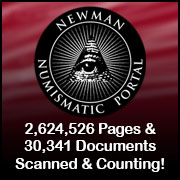
About UsThe Numismatic Bibliomania Society is a non-profit association devoted to the study and enjoyment of numismatic literature. For more information please see our web site at coinbooks.org SubscriptionsThose wishing to become new E-Sylum subscribers (or wishing to Unsubscribe) can go to the following web page link MembershipThere is a membership application available on the web site Membership Application To join, print the application and return it with your check to the address printed on the application. Print/Digital membership is $40 to addresses in the U.S., and $60 elsewhere. A digital-only membership is available for $25. For those without web access, write to: Charles Heck, Treasurer AsylumFor Asylum mailing address changes and other membership questions, contact Chuck at this email address: treasurer@coinbooks.org SubmissionsTo submit items for publication in The E-Sylum, write to the Editor at this address: whomren@gmail.com
BUY THE BOOK BEFORE THE COINSale Calendar
|
- WAYNE'S WORDS: THE E-SYLUM JULY 26, 2020
- KOLBE & FANNING BUY OR BID SALE NUMBER 13
- NEW BOOK: COLONIAL HISTORY IN YOUR HANDS
- NEW BOOK: THE FIRST MEDALS OF AMERICA
- NEW BOOK: ALABAMA OBSOLETE NOTES 1818-1885
- BOOK REVIEW: 100 GREATEST MODERN WORLD COINS
- ALAN ANTHONY (1950-2020)
- A VERMONT NUMISMATIC ENIGMA
- VIDEO: GILROY ROBERTS NUMISMATIC PROFILE
- VIDEO CONFERENCE: ANS FROM ACORN TO SAPLING
- MINT DIRECTOR MOY ON THE COVID-19 COIN SHORTAGE
- NOTES FROM E-SYLUM READERS: JULY 26, 2020
- TAMS 2020 ANNUAL MEETING GOES VIRTUAL
- LANGE: PRR LOCOMOTIVE, 1ST SHIELD NICKEL FOLDER
- VOCABULARY TERM: METALLIZED SURFACE
- REV. MARK RICHARDS WATKINSON (1824-1877)
- ZECHMAN, FEITL RECEIVE ANA 2020 SCHOLARSHIPS
- S.S. CENTRAL AMERICA TREASURES IN GOLDBERG’S SALE
- 2020 ANA INNOVATION DOLLAR NGC SLAB OFFERED
- WOKEFIELD IRON AGE GOLD COIN FIND
- COINAGE OF THE EMPRESS IRENE
- WAYNE'S NUMISMATIC DIARY: JULY 26, 2020
- TRUMP PRESIDENTIAL MEDAL DESIGNS RECOMMENDED
- TRUMP-REAGAN FUNDRAISING COIN KERFUFFLE
- THE FIVE UNIQUE SPEELMAN-WHITE UNCUT SHEETS
- GRINNELL SERIES 1914 AND 1918 FRN PROOFS
- COSTA RICA ISSUES NEW POLYMER BANKNOTES
- INDIAN INDEPENDENCE BRITISH NOTE COUNTERFEITS
- THE NEW YORK FEDERAL GOLD VAULT
- LOOSE CHANGE: JULY 26, 2020
- PLAYFUL ORIGAMI USING BANKNOTES
- FEATURED WEB PAGE: LATIN AMERICAN BANKNOTE MAPS
Click here to access the complete archive
Click here to unsubscribe (scroll down)
To comment or submit articles, reply to whomren@gmail.com
Content presented in The E-Sylum is not necessarily researched or independently fact-checked, and views expressed do not necessarily represent those of the Numismatic Bibliomania Society.
WAYNE'S WORDS: THE E-SYLUM JULY 26, 2020
 New subscribers this week include:
David Weidgenannt of the Institute for Numismatics and Monetary History at the University of Vienna;
Bob Campbell, Steve Hatfield, Peter Jones, Gary Pierson and hundreds of other former ANA Edition readers. While we no longer publish an edition to members of the American Numismatic Association, the ANA kindly invited those readers to subscribe here, and they did in droves, at a rate sometimes as high as 2 or 3 per minute.
Welcome aboard! We now have 6,483 subscribers.
New subscribers this week include:
David Weidgenannt of the Institute for Numismatics and Monetary History at the University of Vienna;
Bob Campbell, Steve Hatfield, Peter Jones, Gary Pierson and hundreds of other former ANA Edition readers. While we no longer publish an edition to members of the American Numismatic Association, the ANA kindly invited those readers to subscribe here, and they did in droves, at a rate sometimes as high as 2 or 3 per minute.
Welcome aboard! We now have 6,483 subscribers.
Thank you for reading The E-Sylum. If you enjoy it, please send me the email addresses of friends you think may enjoy it as well and I'll send them a subscription. Contact me at whomren@gmail.com anytime regarding your subscription, or questions, comments or suggestions about our content.
This week we open with a numismatic literature sale, three new books, a review, updates from the Newman Numismatic Portal and more.
Other topics this week include colonial coins, Comitia Americana medals, U.S. Mint engraver Gilroy Roberts, the early history of the American Numismatic Society, auction offerings of S.S. Central America treasure coins, Trump Presidential Medal designs, the Speelman-White uncut sheets, and Costa Rica's new banknotes.
To learn more about Dr. Peter Jones, Alan Anthony, Alabama obsolete notes, the "Vermont Numismatic Enigma", A. M. Smith publications, $10,000 notes, the Dickeson Continental Dollar, the Lesher House Restoration Souvenir dollar, and the New York Federal Reserve Bank gold vault, read on. Have a great week, everyone!
Wayne Homren
Editor, The E-Sylum
KOLBE & FANNING BUY OR BID SALE NUMBER 13
Numismatic Booksellers Kolbe & Fanning submitted this announcement of their thirteenth "Buy or Bid Sale" which closes on August 4, 2020. Good luck, everyone! -Editor
 Kolbe & Fanning Numismatic Booksellers have announced our thirteenth "Buy or Bid Sale,” which begins now and will close on Tuesday, August 4, 2020. With hundreds of new additions, the sale focuses on modestly priced books, giving collectors an opportunity to add to their libraries at minimal cost.
Kolbe & Fanning Numismatic Booksellers have announced our thirteenth "Buy or Bid Sale,” which begins now and will close on Tuesday, August 4, 2020. With hundreds of new additions, the sale focuses on modestly priced books, giving collectors an opportunity to add to their libraries at minimal cost.
The sale includes over 1400 works on ancient, medieval and modern coins, as well as general works, periodicals and sale catalogues. "Buy” prices have been kept low to promote sales. To further encourage participation, the firm is offering free domestic shipping to bidders spending at least $300; there is also no packing and processing fee for this sale. Again, please read the Terms of Sale before participating.
As the name of the sale suggests, customers may bid on items they wish to acquire or buy them outright at the published price. The Terms of Sale will give full instructions on how to participate: please read it carefully.
There is no printed catalogue. The PDF catalogue is available now for downloading from the Kolbe & Fanning website at numislit.com. Please send all bids to orders@numislit.com or use the bid sheet included at the end of the PDF catalogue.

NEW BOOK: COLONIAL HISTORY IN YOUR HANDS
Author Peter Jones has published a new book on U.S. colonial coinage. Congratulations! See the web page and click the "See Inside" link for a preview, including an introduction by John Kraljevich and a thorough review of earlier classification schemes and a reasoned recommendation for a revision to how these issues have been organized in the past. -Editor
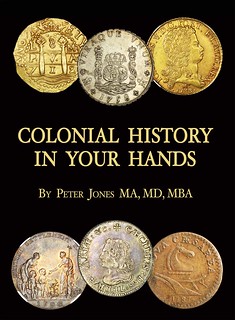 Colonial History in Your Hands
Colonial History in Your Hands
A Colonial Coin Collector's Collection
by Peter Jones
Genre: ANTIQUES And COLLECTIBLES
Subgenre: Coins, Currency & Medals
Language: English
Pages: 598
Format: Hardcover
Hardcover ISBN: 9781098317553
Price: $89 Net
Overview
Colonial History in Your Hands is about colonial American coins. A lifelong collector, Jones explores different classification systems of colonial coins, then gives the fascinating stories behind each coin with up to date scholarship on the current thoughts about each series.
The book is profusely illustrated with color photos, and includes full page pictures of almost 300 coins. The book is 8.5 by 11 hard back with 597 pages. Foreword by John Kraljevich.
Sections include: British royal authorized coins, French royal authorized coins, French Royal domestic export for the colonies, Locally made tokens and coins, Imported token coinage, State Coinage and imitation halfpence, Proposed and actual federal pieces, Optional colonial collectibles (Washingtonia, Condor Tokens, Commodity money, Common Foreign trade coins, little used pieces, and coins which should not be in the Red Book).
There is an extensive glossary which includes: numismatic terms, parts of a coins, English, French and Mexican metrology US GDP, population, and labor costs from 1790 to 2017 Colonial English, Spanish, French and Portuguese rulers, Historical metrology and fineness. Bibliography. Full page color illustrations of 27 foreign coins specified in the Journals of Continental Congress. 13 page index. If you have any interest in colonial American history, colonial American coins, or numismatics in general, this reference book is eminently readable and a must for your collection.
Passionate collector, Dr. Peter Jones describes his fascination with colonial American coins. You can actually feel the connection to the past when you hold a colonial coin in your hand. A colonist once held the same coin!
This book tells the stories behind colonial coins. Peter trained at Cambridge and Oxford Universities, UK, doing a dual residency in Family Practice and Internal Medicine. In 1977 he immigrated with his wife, Ann, and their three daughters to rural Connecticut, where he practiced Internal Medicine for 39 years.
His avocations have included classical piano playing, flamenco and classical guitar playing, American financial history, magic, and numismatics. He has also authored Notable Notes, Dow Jones by Peter Jones, Commemorative Coin Tales, The First Medals of America, and with Cynthia Adams, Therapeutic Communication, now in its third edition.
For more information, or to order, see:
Colonial History in Your Hands
(https://store.bookbaby.com/book/colonial-history-in-your-hands)
Apply code SIXTYOFF for $60 off. Net $89
NEW BOOK: THE FIRST MEDALS OF AMERICA
Peter Jones also published a new book on Comitia Americana and associated medals, the first medals of America. I'll look forward to seeing them both. -Editor
 The First Medals of America
The First Medals of America
Comitia Americana and Associated Medals
by Peter Jones
Genre: HISTORY
SubGenre: United States / Revolutionary Period (1775-1800)
Language: English
Pages: 100
Format: Hardcover
Hardcover ISBN: 9781098325190
Price: $29.99 Net
Overview
People interested in coin collecting, medal collecting, and American Revolutionary history will enjoy this read. The American Continental Congress issued eleven medals for valor during the American Revolution. This book tells the stories behind these brave men and their exploits, and the long process of procuring their individual medals. America had no generic medal for valor at the time. They also had no mint, so had to have France and their sculptors create each medal. This was a labor of love for Franklin and Jefferson while they were Ambassadors to France. Thomas Jefferson himself collected the medals, and presented a set of them to George Washington. Collectors of these medals often include other medals sculpted by the same engravers and struck in Paris relating to the American Revolution. Twenty-six medals are pictured in full page color photographs. The book includes full information about types of medals available and their cost. Foreword by Neil Musante.
Description
People interested in coin collecting, medal collecting, and American Revolutionary history will enjoy this read. The American Continental Congress issued eleven medals for valor during the American Revolution. This book tells the stories behind these brave men and their exploits, and the long process of procuring their individual medals. America had no generic medal for valor at the time. They also had no mint, so had to have France and their sculptors create each medal. This was a labor of love for Franklin and Jefferson while they were Ambassadors to France.
Thomas Jefferson himself collected the medals, and presented a set of them to George Washington.
Collectors of these medals often include in the series other medals sculpted by the same engravers and struck in Paris relating to the American Revolution. People call the collecting area Comitia Americana (Latin for American Congress). Twenty-six medals are pictured in full page color photographs. The book includes full information about types of medals available and their cost. Foreword by Neil Musante.
Topics covered are: Chapter 1. Introduction and Franklin Chapter 2. Medals procured by Franklin: De Fleury 1779 and Libertas Americana 1783 Chapter 3. Dupré's Franklin Medals 1784 & 1786 Chapter 4. Medals procured by Humphreys 1787: Gates and Greene Chapter 5. Jefferson 1789: Washington before Boston Medal Chapter 6. Jefferson 1789: two remaining Stony Point Medals, Wayne & Stewart Medals Chapter 7. Jefferson 1789: 3 Cowpens medals; Morgan, William Washington & Howard Medals Chapter 8. William Short 1789: Jones Medal Chapter 9. Jefferson and Short: Diplomatic Medal Chapter 10. Lee Paulus Hook Medal Chapter 11. Related medals: Treaty of Paris Medal, Lafayette Vengeur Medal Table of types of Comitia Americana Medals and prices, Timeline, Lists, Index.
For more information, or to order, see:
THE FIRST MEDALS OF AMERICA
(https://store.bookbaby.com/book/the-first-medals-of-america)
Apply code TENOFF for $10 off. Net $29.99.
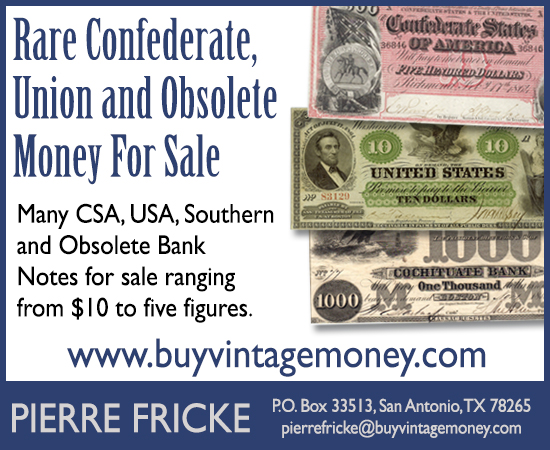
NEW BOOK: ALABAMA OBSOLETE NOTES 1818-1885
A new catalog of Alabama obsolete notes has been published. Congratulations to authors Bill Gunther and Charles Derby. As a summary, here's the book's Preface by Mack Martin, author of State of Georgia Treasury Notes, Treasury Certificates, and Bonds. A Comprehensive Collector’s Guide. -Editor
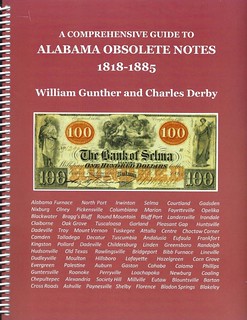 As a collector of obsolete paper money, I certainly enjoyed browsing through and participating
in this new Alabama book, A Comprehensive Guide to Alabama Obsolete Notes 1818-1885, by
Bill Gunther and Charles Derby. The authors have undertaken a complete listing of the
currently known paper money from the State of Alabama from 1818 to 1885. This book is
designed to be a collector’s guide that lists notes from all cities, counties, and issuers including
national notes, state notes, and private scrip from Alabama counties, towns, railroads, and
merchants. Cross-over notes involving other states are also represented. The notes are
illustrated in vivid color and are listed using a new, easy to understand numbering system that
includes many variations of notes based on dates, designs, fonts, and text details. Rarity values
using the 1 to 7 scale of Walter Rosene Jr., who wrote the 1984 catalog on Alabama obsolete
currency, are updated, and prices are listed in low, high, and average values.
As a collector of obsolete paper money, I certainly enjoyed browsing through and participating
in this new Alabama book, A Comprehensive Guide to Alabama Obsolete Notes 1818-1885, by
Bill Gunther and Charles Derby. The authors have undertaken a complete listing of the
currently known paper money from the State of Alabama from 1818 to 1885. This book is
designed to be a collector’s guide that lists notes from all cities, counties, and issuers including
national notes, state notes, and private scrip from Alabama counties, towns, railroads, and
merchants. Cross-over notes involving other states are also represented. The notes are
illustrated in vivid color and are listed using a new, easy to understand numbering system that
includes many variations of notes based on dates, designs, fonts, and text details. Rarity values
using the 1 to 7 scale of Walter Rosene Jr., who wrote the 1984 catalog on Alabama obsolete
currency, are updated, and prices are listed in low, high, and average values.
One of the major enjoyments that I have in collecting these notes is researching and learning about the stories of their origins and history. This is a highlight of this book, as it includes such information on many of the notes. This inclusion is not unexpected given that Gunther and Derby are scholars of Alabama and other Southern paper money and frequently publish articles on the subject in the Society of Paper Money Collectors’ magazine, Paper Money.
Gunther and Derby’s book includes a total of over 1500 notes from over 150 cities and over 400 issuers. This is certainly a world of difference from the first attempt to catalogue Alabama paper money over 100 years ago by Alexander Boyd Andrews, who in 1922 listed 27 notes from six cities. This new book even includes notes from over 40 new cities and over 100 new issuers than in Rosene’s catalogue, now 36 years old.
A Comprehensive Guide to Alabama Obsolete Notes 1818-1885 is a great book for any library and I highly recommend this exclusive work to all who have an interest in early paper money and its history.
- Spiral bound, soft cover, 296 pages, 8 1/2 inch by 11 inch size
- Introduction with a history of Alabama paper money
- 1500+ notes from 400+ issuers in 150+ cities and towns
- 600+ new notes from 100+ new issuers in 40+ new cities than listed in Rosene
- Color images of most notes
- Rarities and prices included
- New catalog system with cross referencing to Rosene catalog #s
- Complete table of contents for every city and issuer
To Order
Send $49.95 + postage ($5 domestic, $10 international) to: Charles Derby, 204 Sycamore Ridge Drive, Decatur, GA 30030. For more information, contact charlesderbyga@yahoo.com
About the Authors
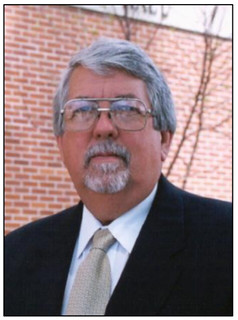 William Gunther stumbled across a Bank of Selma $5 note in a coin shop
in Brighton, England, while on sabbatical leave from the University of Alabama in
1976. That chance discovery led to over 40 years of collecting and researching
these fascinating items. He is a member of the SPMC and ANA and has published
articles on paper money in Paper Money and The Numismatist as well as the
internet blog of the International Bond & Share
Society. He served as a contributing editor on
Alabama notes for Don Kelly’s Obsolete Paper
Money (2018). His personal Alabama collection has
won numerous awards from the Society of Paper
Money Collectors. He retired from the University of
Alabama as Emeritus Professor of Economics, with
over 150 research papers and several books
including Economic, Industrial and Managerial
Coordination Between Japan and the USA. He was
inducted into the Faculty Hall of Fame, Culverhouse
College of Commerce and Business Administration,
The University of Alabama, in May 2005.
William Gunther stumbled across a Bank of Selma $5 note in a coin shop
in Brighton, England, while on sabbatical leave from the University of Alabama in
1976. That chance discovery led to over 40 years of collecting and researching
these fascinating items. He is a member of the SPMC and ANA and has published
articles on paper money in Paper Money and The Numismatist as well as the
internet blog of the International Bond & Share
Society. He served as a contributing editor on
Alabama notes for Don Kelly’s Obsolete Paper
Money (2018). His personal Alabama collection has
won numerous awards from the Society of Paper
Money Collectors. He retired from the University of
Alabama as Emeritus Professor of Economics, with
over 150 research papers and several books
including Economic, Industrial and Managerial
Coordination Between Japan and the USA. He was
inducted into the Faculty Hall of Fame, Culverhouse
College of Commerce and Business Administration,
The University of Alabama, in May 2005.
 Charles Derby received a scrapbook of Southern paper money collected by
his great-grandmother, Essie Lambeth, a North Carolinian who held meetings at
her house of the local chapter of the United
Daughters of the Confederacy. From that beginning,
his interests in Southern paper money grew. He is a
member of the SPMC and ANA and an author of
articles on paper money published in Paper Money,
North Carolina Numismatic Scrapbook, New England
Numismatic Association News, and Georgia
Numismatic Association Newsletter. When not
research and collecting paper money, he is a Regents’
Professor at Georgia State University, with over 150
papers and a book, Natural History of Crustacea:
Nervous Systems and Control of Behavior.
Charles Derby received a scrapbook of Southern paper money collected by
his great-grandmother, Essie Lambeth, a North Carolinian who held meetings at
her house of the local chapter of the United
Daughters of the Confederacy. From that beginning,
his interests in Southern paper money grew. He is a
member of the SPMC and ANA and an author of
articles on paper money published in Paper Money,
North Carolina Numismatic Scrapbook, New England
Numismatic Association News, and Georgia
Numismatic Association Newsletter. When not
research and collecting paper money, he is a Regents’
Professor at Georgia State University, with over 150
papers and a book, Natural History of Crustacea:
Nervous Systems and Control of Behavior.
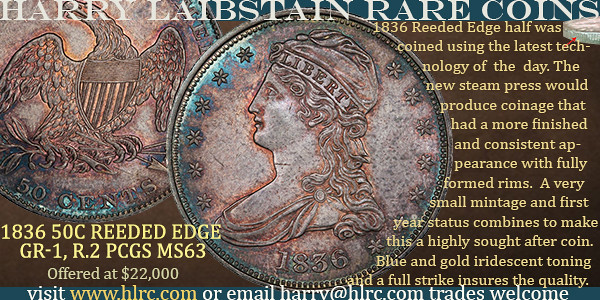
BOOK REVIEW: 100 GREATEST MODERN WORLD COINS
On July 21, 2020 Lou Golino published a review on CoinWeek of the Whitman book 100 Greatest Modern World Coins by Charles Morgan and Hubert Walker. Here's a short excerpt - see the complete article online. -Editor
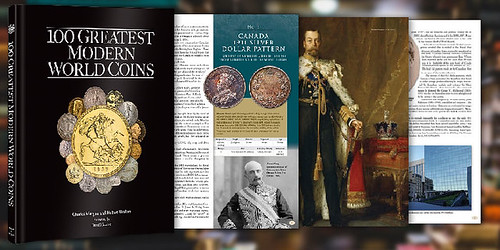
In choosing their 100 greatest world coins of the 20th century, the authors build on the criteria set forth in the first Whitman book in the "100 Greatest” series, Jeff Garrett and Ron Guth’s 100 Greatest U.S. Coins, which were: rarity, value, quality, popularity, beauty and history.
But unlike the coins of the earlier volume that form a homogenous group, the much more diverse group of coins issued around the world since 1901 required a different set of criteria for the authors, which are: rarity; innovation (such as new metal alloys, new motifs, and coinage reforms); coin sets (a number of the greatest world coins include special coin sets or were part of sets); oddities and emergency issues, such as coins issued just before a leader was overthrown; and auction and market values.
Emphasis on Rarity
The authors acknowledge that the coins that made their list include a large number that are so rare and valuable that they are well beyond the means of most collectors – or are even impossible to own for various reasons. In fact, only 23% of the coins discussed here are valued under $10,000, but Charles and Hubert do include some issues that any collector can afford, such as #100, the 1999 euro coin set, and a couple of modern bullion issues, such as #57, the 1967 South African gold Krugerrand and #66, the 1979 Canadian Gold Maple Leaf, the first two modern world gold bullion coins.
The book covers the rarest and most numismatically significant issues from countries around the world that are, in many cases, not well known outside the country where they were issued. Others are well known to those who collect coins of specific countries, such as #7, the Proof version of the 1930 Melbourne Penny from Australia, which is considered the "King of Australian Coins”, or #1, the 1911 Canada Silver Dollar Pattern, of which only two exist and only one of them is in private hands.
The article includes an interesting discussion of criteria for classifying a coin as modern, and criteria for considering a modern coin as one of the greatest. Date of manufacture? Process of manufacture? Rarity, value, quality, popularity? Beauty, history, innovation, oddity, market value? See the article for an overview, but read the book to see the results. -Editor
To read the complete article, see:
First Read: 100 Greatest Modern World Coins… Review by Louis Golino
(https://coinweek.com/world-coins/first-read-100-greatest-modern-world-coins-review-by-louis-golino/)
To read the earlier E-Sylum articles, see:
NEW BOOK: 100 GREATEST MODERN WORLD COINS
(https://www.coinbooks.org/v22/esylum_v22n52a02.html)
BOOK REVIEW: 100 GREATEST MODERN WORLD COINS
(https://www.coinbooks.org/v23/esylum_v23n03a04.html)
THE BOOK BAZARRE
ALAN ANTHONY (1950-2020)
Author Roger Moore of the Colonial Coin Collectors Club submitted this remembrance of collector and researcher Alan Anthony of Leesburg, VA. Thank you. -Editor
 The passing of Alan on July 23, 2020 was a blow for all of us. We have lost a friend and a colleague who was knowledgeable in many areas of colonial numismatics and willing to openly share that knowledge with anyone willing to talk. He has been described as a reserved "good ole boy,” whose gravelly voice, when he spoke, was distinctive. Because he was reticent in talking about himself, many of us know little about his background. His wife – Kathy – helped to fill in some of the details:
The passing of Alan on July 23, 2020 was a blow for all of us. We have lost a friend and a colleague who was knowledgeable in many areas of colonial numismatics and willing to openly share that knowledge with anyone willing to talk. He has been described as a reserved "good ole boy,” whose gravelly voice, when he spoke, was distinctive. Because he was reticent in talking about himself, many of us know little about his background. His wife – Kathy – helped to fill in some of the details:
Alan graduated high school in 1969, was drafted into the Army Infantry, and wound up doing a year in Vietnam. His eyesight was so good, he was quickly trained as a sniper. He was lucky to survive and was shot only once. Feeling bullet proof upon his return home, he raced cars and motorcycles at Summit Point and Road Atlanta and finally settled into a job as an auto mechanic after turning down training for Air Traffic Control. Working in many shops, he achieved a master mechanic rating in 7 out of 8 ASE certifications. After a time, he was promoted to General Manager of Herndon Automotive. He worked 12 hour days 6 days a week for many years. Through it all was always his love of coins.
She added,
Alan was never so happy as when he could go to a coin convention, whether a large conference or a small gathering of 20 vendors in a community center. As you know, coins were his passion. I used to tease him to buy a Rosa for me whenever he’d go to Baltimore, because his Rosa collection was really mine. He’d come smiling through the door, "Sorry, but Syd bought your Rosa.”
Alan’s interest in all types of colonial coins was impressive, but his greatest love was Virginia halfpence. One should not be surprised that he placed Virginia halfpence above all other series based on his choice of an email address - vacoinage@aol.com. Along with Richard Picker, Jim Spilman and Eric Newman, Alan was one of a handful of pioneers collecting and researching Virginia halfpence. His research got a boost at the 2001 C4 convention in Boston, when he met Eric Newman and later established active communication with him. This communication increased when Jim Spilman developed the Colonial Newsletter Foundation yahoo based e-groups, one of which was for Virginia halfpence. Eric and Alan were two of the first to join the group. A number of their email exchanges, as well as private communications, are available on the Newman Numismatic Portal. I had a laugh-out-loud moment when I read a private email from Alan to Eric on April 4, 2004 referring to me that said, "I am in the process of trying to clarify Roger’s CNL paper. … a good dose of Roger’s enthusiasm is not a bad thing for me to catch. Perhaps I can infect him with some patience and perseverance.” He was not successful on patience, but he did make our paper better!!
November 2004 was a tough time for Alan since his wife became very ill. Thankfully she recovered but he had to miss the C4 convention that year. However, his sorrow in missing the convention was easily forgotten in 2005 when he made the discovery of a new Virginia variety – the 15-W. I remember how he let me know about this new find. He sent me an email with images of the coin without saying anything about it. When I attributed it for what it was, he finally revealed his real excitement which he had hidden until then. We wrote up his discovery in the December 2005 issue of The Colonial Newsletter.
On March 9, 2006, in an email to the C4 Colonial Coins Yahoo group, Alan posted a sketch of his numismatic interests, based on a request that all members to provide a brief introduction to themselves. He stated, as written:
I am Alan anthony aka vacoinage on ebay Male 55 year old I have been a coin collector since I was a child Lincoln cents, Indians, Large cents, Red Book Type That is where it all went wrong I decided around the late 70 s that I probably needed to get some of those Colonial Thingees in the front of the Red Book for my type set. My first colonial was a Miller 1787 33 Z CT that I got at a local auction for $35, I still have it and could not sell it for $35 today. It got me started though. My few for type has turned into boxes full and I have lost all interest in all other coins. Hell my colonial library is probably worth more than my federal coin collection. I research and collect Virginia Halfpence, collect Red Book colonials by type (most by die variety) and I love Fugios.
Though very reserved and quiet in demeanor, Alan was an active participant in co-authoring papers, and providing exhibits at C4 Conventions. At the 2014 convention his exhibit was, "Odd and Curious Colonials.” At the 2019 C4 Convention he helped me complete the "Virginia Halfpence” exhibit by supplying two coins needed to have all known varieties together at one time and one place for the first time in history. A photo of us at the exhibit is provided below. The passing of Alan at this time in his life is especially tragic, since just a little over a year ago he retired. With retirement he had more time for travel with his loving wife, Kathy, as well as numismatics. Having spoken to Alan just last week, neither he nor his wife expected things to change so quickly. I feel a personal loss in his passing and will miss having a partner for discussing new discoveries surrounding the Virginia halfpence.
His wife has requested that at our next C4 gathering that we lift a glass in his memory, since he considered all of you to be his best friends. We will miss you, my friend!
Roger Moore


Left) Alan and me at our Virginia Halfpence exhibit during the 2019 C4 Convention and Right) Alan at the 2018 C4 convention.
For more information on the Colonial Coin Collectors Club, see:
https://colonialcoins.org/

A VERMONT NUMISMATIC ENIGMA
The latest addition to the Newman Numismatic Portal is a video on the "Vermont Numismatic Enigma". Project Coordinator Len Augsburger provided the following report. Thanks. -Editor
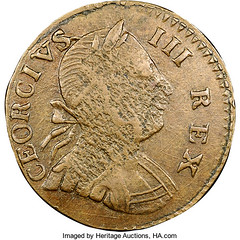
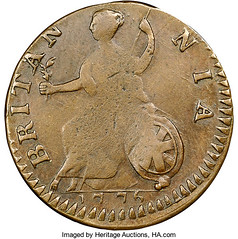
Getting to Know Eric P. Newman, Part 3: A Vermont Numismatic Enigma
Lianna Spurrier continues her video series on numismatic publications of Eric P. Newman, with the latest installment focusing on his 1958 publication "A Recently Discovered Coin Solves a Vermont Numismatic Enigma.” In this article, Newman sought to explain why Vermont coppers minted during the Confederation period bore British insignia. With an assist from Walter Breen, Newman uncovered a punch interlock between certain 1786 Vermont coppers and Machin’s Mills counterfeit halfpence of the same period, demonstrating that the British Union was intentionally reused on the Vermont reverse die, most likely as a cost saving measure. Today, about a dozen examples of the "Vermont Enigma” die pairing are known, with the finest piece selling in the Newman IV sale in 2014.
Images: The Vermont Enigma coin, 1776 Machin’s Mills Halfpence, NGC MS62 Brown, Vlack 9-76B, Breen Encyclopedia plate coin, ex. Newman IV (Heritage Auctions, 11/2014, lot 3030, realized $35,250).
Link to A Vermont Numismatic Enigma video on Newman Portal:
https://nnp.wustl.edu/library/book/586143
VIDEO: GILROY ROBERTS NUMISMATIC PROFILE
These are selections from the David Lisot Video Library that feature news and personalities from the world of coin collecting. David has been attending coin conventions since 1972 and began videotaping in 1985. The Newman Numismatic Portal now lists all David’s videos on their website at:
https://nnp.wustl.edu/library/multimediadetail/522852
This one is an in-depth interview with U.S. Mint engraver Gilroy Roberts. -Editor
Gilroy Roberts Numismatic Profile, March 14, 1991, 2 of 2
 Hear and see the great medallic sculptor Gilroy Roberts in this in-depth interview conducted by David Lisot. Gilroy shares his childhood and what inspired him to become an artist. He discusses his days at the U.S. Mint when he had the opportunity to design the Kennedy half dollar. He tells of his prolific artistic creations at the Franklin Mint. This interview is an inspiration into the creative spirit as told by one of the most successful sculptors of all time. Interviewed by David Lisot.
Hear and see the great medallic sculptor Gilroy Roberts in this in-depth interview conducted by David Lisot. Gilroy shares his childhood and what inspired him to become an artist. He discusses his days at the U.S. Mint when he had the opportunity to design the Kennedy half dollar. He tells of his prolific artistic creations at the Franklin Mint. This interview is an inspiration into the creative spirit as told by one of the most successful sculptors of all time. Interviewed by David Lisot.
The video is available for viewing on the Newman Numismatic Portal at:
https://nnp.wustl.edu/library/book/548839

VIDEO CONFERENCE: ANS FROM ACORN TO SAPLING
Another American Numismatic Society Money Talks video conference has been scheduled. NOTE: these are open to members only. Great time to join! This is a great topic for numismatic bibliophiles and students of U.S. numismatic history. -Editor
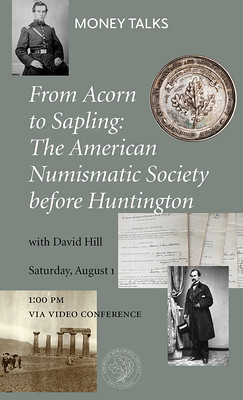 MONEY TALKS
MONEY TALKS
From Acorn to Sapling: The American Numismatic Society before Huntington
With David Hill
Saturday, August 1
1:00 pm ET
This Money Talks will be held live via video conference. As with any Money Talks, you will be able to ask questions and hear responses in real time. The session is open to ANS members only. RSVP to Emma Pratte at membership@numismatics.org to get the link.
The ANS’s symbol is the mighty oak grown from a tiny acorn. But the tree didn’t become fully rooted until after 1905, when Archer Huntington—who gave the Society a building, a professional staff, and a firm commitment to scholarly publishing—became president. We will look at the Society during its pre-Huntington, "sapling” years, taking into consideration its members as well as other nineteenth-century numismatic groups.
Money Talks: Numismatic Conversations is supported by an ANS endowment fund generously given in honor of Mr. Vladimir Clain-Stefanelli and Mrs. Elvira Clain-Stefanelli.
To read the complete article, see:
From Acorn to Sapling: The American Numismatic Society before Huntington
(http://numismatics.org/mt-hill-20/)

MINT DIRECTOR MOY ON THE COVID-19 COIN SHORTAGE
Former U.S. Mint Director Ed Moy published an article on Newsmax Finance about the coronavirus coin shortage. Here's an excerpt. -Editor
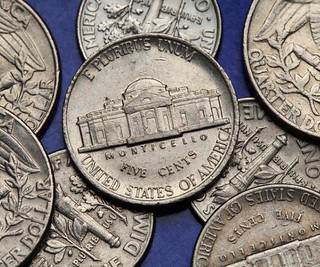 The amount of coins in the economy hasn’t changed. It is the flow of those coins that has.
The amount of coins in the economy hasn’t changed. It is the flow of those coins that has.
Businesses make and receive change when customers pay in cash. Then these businesses deposit coins at their banks. There, the worn-out ones are culled and the rest are wrapped in rolls that businesses use when they run low.
When banks run low, they order more from the Federal Reserve, and when the Fed’s inventory runs low, they place orders for more from the United States Mint.
This is the normal circulation of coins. COVID has disrupted it.
Many businesses are closed; coins are sitting in their cash registers. Most of those who have re-opened are avoiding handling cash as a means of stopping the spread of COVID. Instead the vast majority of transactions are now done with electronic payments like credit and debit cards.
Customers have also been impacted. Trips to the bank and grocery stores are less frequent and cashing in accumulated coins a less important errand. And, as is customary in times of economic crisis, others are hoarding cash as a precaution for a "rainy day.”
Operations at the United States Mint have not gone unchanged by the pandemic either. On top of the suppliers (and thus supply) reacting to COVID, the Mint has had to sanitize its manufacturing plants, adapt to newly complicated logistics, and reduced staff due to social distancing. And its manufacturing plants have been forced to close from time to time due to a few employees testing positive for the virus. This has all in turn shrunk its manufacturing capacity: Production is currently down while demand is up.
The United States Mint exists to make enough circulating coins to facilitate economic transactions. This shortage illustrates just how important coins, and more broadly cash, are to the world’s largest economy, even in the modern age of electronic transactions.
However, our nation’s coin shortage is merely temporary. It is an unintended consequence of COVID and our government’s response to it. As the economy opens more, usage patterns will normalize, and as the United States Mint’s production catches up, coin supply will increase just like toilet paper has.
To read the complete article, see:
Coin Shortage or Cashless Conspiracy?
(https://www.newsmax.com/Finance/ed-moy/coin-shortage-cashless-conspiracy/2020/07/24/id/978938/)
To read the U.S. Mint's official statement, see:
United States Mint statement on circulating coins
(http://news.coinupdate.com/united-states-mint-statement-on-circulating-coins/)
One man in Wisconsin took this opportunity to cash in a 20-year accumulation of change. -Editor
 For more than 20 years, Jim Holton of Wauwatosa has been collecting coins. It all started with a piggy bank given to his son when he was born. Every day since Holton has been filling it up with his spare change Two decades later it's parlayed into three 5 gallon buckets of change.
For more than 20 years, Jim Holton of Wauwatosa has been collecting coins. It all started with a piggy bank given to his son when he was born. Every day since Holton has been filling it up with his spare change Two decades later it's parlayed into three 5 gallon buckets of change.
"I heard on the radio they were having a coin shortage and with everything going on; I was like, 'I can help,"' says Holton.
On Thursday afternoon at North Shore Bank in Brookfield, Holton decided it was time to cash in. According to Holton’s weight predictions, each bucket weighs about 100 pounds. The buckets were wheeled in because they were too heavy to lift.
Holton got a workout just wheeling the money inside the bank.
"It’s heavy I am sweating," says Holton.
Jim’s final tally rang in at $5,366.05.
To read the complete article, see:
Coin Collector Cashes in to Help with Shortage During Coronavirus Pandemic
(https://spectrumnews1.com/wi/madison/news/2020/07/24/coin-shortage-coronavirus-pandemic-bank-collector)

NOTES FROM E-SYLUM READERS: JULY 26, 2020
A. M. Smith Publications
Regarding Dave Hirt's questions about a book title ascribed to A. M. Smith,
Pete Smith writes:
"The A. M. Smith listing for "A History of Colonial Coins" appears in History of The Great Northwest and its Men of Progress published when A. M. Smith was still alive in 1901. Titles like this were typically "vanity" publications. You were considered among the "Men of Progress" if you submitted a biography and paid a fee for the listing. This would be true for the listing for A. M. Smith.
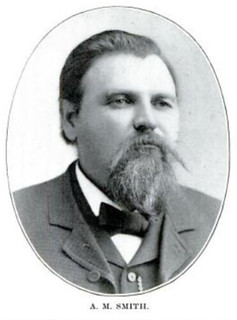 In listing his publications, he did not mention the book that goes by various titles including Illustrated History of the U. S. Mint or Coins and Coinage. Instead he listed items that might be considered chapter titles.
In listing his publications, he did not mention the book that goes by various titles including Illustrated History of the U. S. Mint or Coins and Coinage. Instead he listed items that might be considered chapter titles.
This was apparently one of the primary sources for Jeremy Bostwick's article He was kind enough to refer readers to my exhibit on "The Challenging Literature of A. M. Smith." He did not note the extensive listing and explanation of the various titles of Smith publications.
The Library of Congress lists the author's name as Andrew Madsen Smith and his name was Anders Madsen Smedt at birth. However, the numismatic world has called him Andrew Mason Smith for so long that making the correction is a battle I have not been able to win."
Thank you - nice find. I alerted the Newman Numismatic Portal to this and we'll work to add it to the article database, making it easier for future numismatic researchers to find.
Jeremy told me the information on the titles came via the Smith descendents who consigned the coins being discussed in the article. -Editor
To read the Smith "Men of Progress" article on Google Book
https://books.google.com/books?id=WLfEX7jKMM8C&lpg=
PA405&dq=%22A%20History%20of%20Colonial%20Coins%22&pg=
PA405#v=onepage&q&f=false
To read the earlier E-Sylum article, see:
NOTES FROM E-SYLUM READERS: JULY 19, 2020 : A. M. Smith's "A History of Colonial Coins"
(https://www.coinbooks.org/v23/esylum_v23n29a15.html)
Russian-Printed 1944 Germany 10 Mark Allied Military Note
Last week I noted that there was something different about the 1944 Germany 10 Mark Allied Military Note I'd found on eBay and used to illustrate an article. It was a tough question - no one ventured a guess. -Editor

Joe Boling writes:
"The note illustrated was printed by the Russians, so it is unlikely that our hero would have been carrying it. The US-printed notes (same design) have a nine-digit serial number printed by a numbering device with nine wheels. The Russians didn’t have nine-wheel equipment - they had to kludge together a six-wheel and a three-wheel machine, thus the irregularity in the serial number. There is also a printer’s colophon on the US-produced pieces that is missing from the Russian pieces."
Thanks! Interesting history. -Editor
To read the earlier E-Sylum article, see:
NOTES FROM E-SYLUM READERS: JULY 19, 2020 : Allied Military Note
(https://www.coinbooks.org/v23/esylum_v23n29a15.html)
Fate of the Krause Standard Catalogs
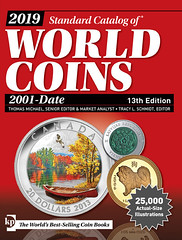 Eric Hyman writes:
Eric Hyman writes:
"Does AIM Media plan to continue publishing the Krause standard catalogs?"
Well, the Standard Catalog was purchased by Penguin Random House, but AIM kept the database. I asked the people at AIM if they could tell us anything about the future of the SCWC, but haven't gotten a response as of publication time. This issue is still up in the air. -Editor
To read earlier E-Sylum articles, see:
KRAUSE NUMISMATIC PERIODICALS UNDER AIM
(https://www.coinbooks.org/v22/esylum_v22n29a07.html)
KRAUSE PUBLICATIONS PHOTO ARCHIVE OFFERED
(https://www.coinbooks.org/v23/esylum_v23n29a02.html)
Editions of The Coinage of Tripura
Regarding editions of The Coinage of Tripura,
Ron Haller-Williams writes:
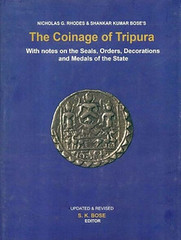 "The first edition was 2002, the "Revised and Updated" one was 2019.
"The first edition was 2002, the "Revised and Updated" one was 2019.
"Nicholas G. Rhodes & Shankar Kumar Bose, "the Coinage of Tripura: With Notes on the Seals, Orders, Decorations and Medals of the State : Revised and Updated"
"This "Revised and Updated" edition (178 pages) was published in 2019, see
https://books.google.co.uk/books?id=_PBBzQEACAAJ
"The previous edition seems to have been published in 2002, see page 144 of The Journal of the Numismatic Society of India, Volumes 64-65 2. Rhodes, N. & Bose, Shanker K., "The Coinage of Tripura with notes on the seals, orders, decorations and medals of the state", Kolkata, 2002, p. 42"
Thank you! -Editor
To read the earlier E-Sylum article, see:
NOTES FROM E-SYLUM READERS: JULY 19, 2020 : Nicholas Rhodes and the Coinage of Tripura Book
(https://www.coinbooks.org/v23/esylum_v23n29a15.html)
Thoughts on The Case of the Bogus Burning Bill
Ron Haller-Williams also submitted these thoughts on The Case of the Bogus Burning Bill:
- "Was the bartender sufficient of an expert on burnt currency?
- Before it was burned, had anybody inspected the note to be sure it wasn't stage (film/theatre prop) or play (toy) money, or with spoof design/inscriptions?
"Even if that $5 bill was a fake AND Harry had been aware of it (but hadn't made it himself or bought it at a discount):
- Did he "pass" the money? NO!
- Is there an absolute law against possession WITHOUT intent? (This would criminalise a victim!)
- Is it not to be applauded that, if he had been passed a fake bill but did not notice until too late, he then proceeded to destroy it?
Also, I believe there is (or should be!) even be a way legitimately to "pass" fake money:
(a) Acquire some "funny money", and place it in your wallet.
(b) Go to a "no-go area", and likely get "dipped" (pickpocketed).
(c) Enjoy it when the thief (or accomplice) gets done for trying to spend the "funny money"."
Fun with funny money. Thanks. -Editor
To read the earlier E-Sylum article, see:
THE CASE OF THE BOGUS BURNING BILL
(https://www.coinbooks.org/v23/esylum_v23n29a26.html)
Trade Token Mudlark Find
Anne Bentley passed along this find by Thames Mudlark Nicola White:
"I recently found a 17th Century traders token in the Thames mud (Traders tokens were issued in the 17th C by traders - bakers,butchers,tailors,inns,taverns,vintners etc.. for low value transactions) "
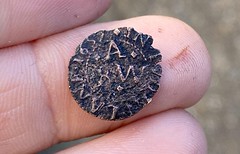
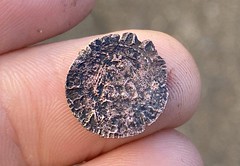
Thanks. neat find. -Editor
To read the original tweet, see:
https://twitter.com/TideLineArt/status/1284892616451129344
Horseshoe Casino $10,000 Notes
Phil Iversen writes:
"About a year or two ago there was mention in the E-Sylum about the removal of the $1 million display of $10,000 notes from the Horseshoe Casino in Las Vegas. Soon after the notes were removed from display in Las Vegas I spotted them during the February 2000 Long Beach Exposition in the dealer case of Jay Parrino's The Mint as indicated on the business card inside the case. Very nice to see, but even nicer to own one...or more!"
Phil had actually sent these photos before, but we've added a lot of new readers since then, so these are well worth a second look. What fun! -Editor
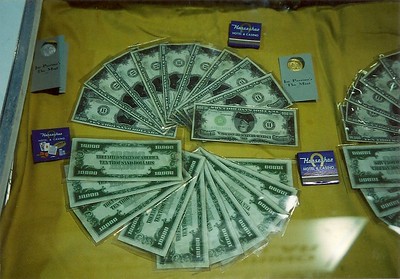
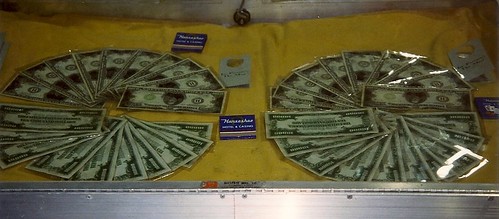
To read earlier E-Sylum articles, see:
NOTES FROM E-SYLUM READERS: FEBRUARY 22, 2015 : Binion’s Horseshoe Casino $10,000 Notes
(https://www.coinbooks.org/esylum_v18n08a10.html)
NOTES FROM E-SYLUM READERS: MARCH 1, 2015 : Binion's Current $Million Display
(https://www.coinbooks.org/esylum_v18n09a12.html)
NOTES FROM E-SYLUM READERS: MARCH 8, 2015 : The Old Binion's $Million Display
(https://www.coinbooks.org/esylum_v18n10a09.html)
Japan's Emperor Akihito and Naruhito Coins
Pabitra Saha writes:
"You had sought some info about coins of new emperor of Japan. Unlike USA, where shortage of coins appears to be a big news, Japan has no demand for coins. I finally got the new 5 yen coin for my collection."
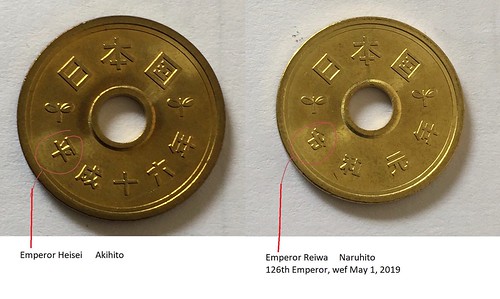
Congratulations on your acquisition! Thanks for the nice graphic. -Editor
To read the earlier E-Sylum articles, see:
NOTES FROM E-SYLUM READERS: APRIL 12, 2020 : Japanese Coin Dates
(https://www.coinbooks.org/v23/esylum_v23n15a19.html)
FEATURED WEB SITE: COIN DATE CONVERTER
(https://www.coinbooks.org/v23/esylum_v23n16a37.html)
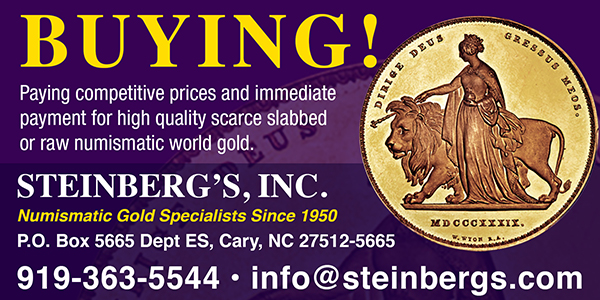
TAMS 2020 ANNUAL MEETING GOES VIRTUAL
The Token and Medal Society will be holding its 2020 Annual Meeting online. Here's the announcement. -Editor
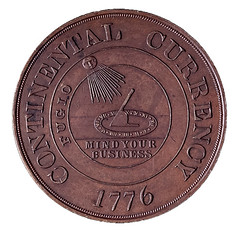
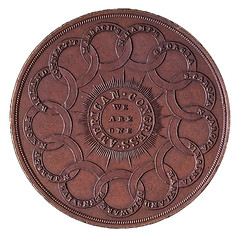
Owing to the cancellation of the ANA World's Fair of Money in August, the Token and Medal Society will hold its annual meeting virtually on Zoom, Wednesday, August 5, 2020 at 2 PM Eastern, 11 AM Pacific Coast time. Members, and others interested in tokens and medals, are invited to join the board for the introduction of new officers and the presentation of annual awards. As is the tradition of the TAMS general meeting, we will feature a program from TAMS members sharing items from their collecting interests. This year Hyder and Shevlin will present new research on the origin of the Dickeson Continental Dollar and the probable and known history of the disposition of the dies.
To access the meeting send an email to either Bill Hyder basktmkr@pacbell.com, Jeff Shevlin socalledguy@hotmail.com or Ernie Nagy ernienagy@gmail.com for the Zoom meeting link and id.
LANGE: PRR LOCOMOTIVE, 1ST SHIELD NICKEL FOLDER
Researcher and author David Lange submitted these notes related to items appearing in our previous issue. Thanks! -Editor
As so often happens, I found something of specific interest in the latest issue that warrants a few comments.
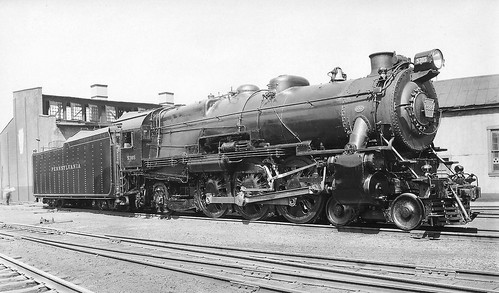
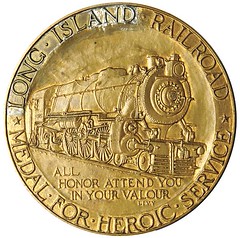 As a youngster my interest in coin collecting had to compete with an equal passion for railroading, both the real thing and in model form. The Pennsylvania Railroad medal for heroic service submitted by Kristen Reichardt depicts that line's celebrated K-4 locomotive, a passenger hauler so successful that 425 examples were built. It has a 4-6-2 wheel configuration, known generically as a Pacific Type. It became a symbol of fast and reliable passenger service starting in 1914 and lasting through the end of steam on the PRR in the late 1950s. Needless to say, there have been many models offered of this superstar in various scales over the years. I'm attaching a photo of No. 5385 that reveals its handsome profile.
As a youngster my interest in coin collecting had to compete with an equal passion for railroading, both the real thing and in model form. The Pennsylvania Railroad medal for heroic service submitted by Kristen Reichardt depicts that line's celebrated K-4 locomotive, a passenger hauler so successful that 425 examples were built. It has a 4-6-2 wheel configuration, known generically as a Pacific Type. It became a symbol of fast and reliable passenger service starting in 1914 and lasting through the end of steam on the PRR in the late 1950s. Needless to say, there have been many models offered of this superstar in various scales over the years. I'm attaching a photo of No. 5385 that reveals its handsome profile.
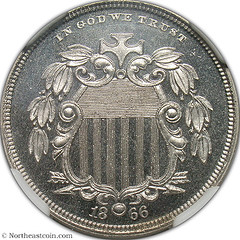
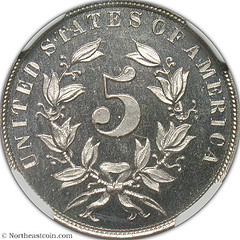
The other item that caught my attention is the pattern Shield Nickel offered by Northeast Numismatics. The First Edition of Whitman's blue coin folder for this series includes two openings for the 1866 nickel, one for the variety having a large date and small motto and the other for the small date and large motto variety. Whoever designed this folder was clearly unaware that the former was solely a pattern coin and not a regular part of the series. This was corrected fairly quickly when someone more knowledgeable pointed out the error. A First Edition folder for Shield Nickels is extremely rare, and I've seen just three examples. These include the one in my own collection and another I sold to a fellow collector. An image from my new book is attached, showing the two varieties.
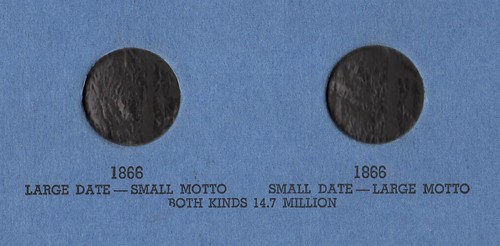
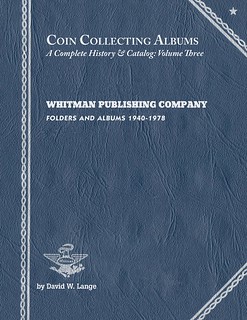 For more information on Dave's book, see:
For more information on Dave's book, see:
NEW BOOK: COIN COLLECTING ALBUMS, VOLUME THREE
(https://www.coinbooks.org/v23/esylum
_v23n25a03.html)
MORE ON COIN COLLECTING ALBUMS, VOLUME THREE
(https://www.coinbooks.org/v23/esylum_
v23n26a08.html)
To read the earlier E-Sylum articles, see:
THE PENNSYLVANIA RAILROAD HEROIC SERVICE MEDAL
(https://www.coinbooks.org/v21/esylum_
v21n39a11.html)
NOTES FROM E-SYLUM READERS: JULY 19, 2020 : On the Pennsylvania Railroad Heroic Service Medal
(https://www.coinbooks.org/v23/esylum_v23n29a15.html)
NUMISMATIC NUGGETS: JULY 19, 2020 : 1866 Shield Nickel Pattern J-489
(https://www.coinbooks.org/v23/esylum_v23n29a21.html)

VOCABULARY TERM: METALLIZED SURFACE
Dick Johnson submitted this entry from his Encyclopedia of Coin and Medal Terminology. Thanks. -Editor
Metallized Surface A nonmetallic surface which is treated to make it appear as metal or to contain some property of metal, as being electrically conductive. Such surfaces are so treated in electrogalvanic work and in certain finishes in the medallic field. A plaster pattern, for example, can be metallized as a first step in forming an electrogalvano. This can be accomplished with a liquid solution (containing minute particles of metal in suspension), or in powder or paste form. Graphite and bronze powders (actually pure copper) are common metallizing agents. Flash metallizing, using a liquid, employs a solution that evaporates rapidly leaving the coated surface with a uniform layer of metal flakes. In electrogalvanic work the metallizing agent not only acts as a primer to start the electrodeposition (because it conducts electricity), but also as a release agent after the form is ready to be separated from the pattern. See electrodeposition.
Looking for the meaning of a numismatic word, or the description of a term? Try the Newman Numismatic Portal's Numismatic Dictionary at: https://nnp.wustl.edu/library/dictionary
Or if you would like a printed copy of the complete Encyclopedia, it is available. There are 1,854 terms, on 678 pages, in The Encyclopedia of Coin and Medal Technology. Even running two a week would require more than 19 years to publish them all. If you would like an advance draft of this vital reference work it may be obtained from the author for your check of $50 sent postpaid. Dick Johnson, 139 Thompson Drive, Torrington, CT 06790.
REV. MARK RICHARDS WATKINSON (1824-1877)
Watkinson, Rev. Mark Richards (1824-1877), born October 24, 1824 in Camden, New Jersey. He married Sarah E. Griffith (1832-) and they had a son Mark W. Watkinson (1863-). His seminary training was at the University of Lewisburg, Pennsylvania, later named Bucknell University, and then at the Columbian College, now George Washington University, in Washington, D.C. In October 1850 he first served at the First Particular Baptist Church in Ridley or Ridleyville, Pennsylvania. On June 10, 1852 he was ordained a Baptist minister at Ridley, Pennsylvania.
The Rev. Watkinson left the church in 1853 to take up service as the pastor of the Schuylkill Baptist Church in Philadelphia, Pennsylvania, where he remained until 1861 to serve as pastor at the First Baptist Church, Richmond, Virginia, but soon left at the outbreak of the Civil War returning to Ridleyville in June 1861 where he remained until 1864. At last he was elected as pastor of the Bethany Baptist Church (Maryland) built in 1873 by Mrs. Mary A. Dodge. He died on September 26, 1877, at the age of 52, and is buried in the Pemberton Baptist Cemetery, Pemberton, Burlington County, New Jersey.
On November 13, 1861 he wrote to Secretary of the Treasury, Samuel P. Chase the following :
"Dear Sir: You are about to submit your annual report to the Congress respecting the affairs of the national finances.
"One fact touching our currency has hitherto been seriously overlooked. I mean the recognition of the Almighty God in some form on our coins.
"You are probably a Christian. What if our Republic were not shattered beyond reconstruction? Would not the antiquaries of succeeding centuries rightly reason from our past that we were a heathen nation? What I propose is that instead of the goddess of liberty we shall have next inside the 13 stars a ring inscribed with the words PERPETUAL UNION; within the ring the allseeing eye, crowned with a halo; beneath this eye the American flag, bearing in its field stars equal to the number of the States united; in the folds of the bars the words GOD, LIBERTY, LAW.
"This would make a beautiful coin, to which no possible citizen could object. This would relieve us from the ignominy of heathenism. This would place us openly under the Divine protection we have personally claimed. From my heart I have felt our national shame in disowning God as not the least of our present national disasters."
As a result of Rev. Watkins’ letter we find that in the following week Secretary Chase instructed James Pollock, then the Director of the Mint at Philadelphia, to prepare a motto, in a letter dated November 20, 1861:
"Dear Sir: No nation can be strong except in the strength of God, or safe except in His defense. The trust of our people in God should be declared on our national coins.
"You will cause a device to be prepared without unnecessary delay with a motto expressing in the fewest and tersest words possible this national recognition."
To read the complete article, see:
WATKINSON, MARK RICHARDS
(https://sites.google.com/site/numismaticmallcom/encyclopedic-dictionary-of-numismatic-biographies/watkinson-mark-richards)
To read an earlier E-Sylum article, see:
1890 LEACH "IN GOD WE TRUST” LETTER SCANNED
(https://www.coinbooks.org/v20/esylum_v20n45a11.html)
THE BOOK BAZARRE
ZECHMAN, FEITL RECEIVE ANA 2020 SCHOLARSHIPS
Congratulations to Abby Zechman and Colin Feitl on being awarded ANA 2020 College Scholarships. Here's the press release. -Editor
The American Numismatic Association (ANA) has awarded 2020 college scholarships to Abigail Zechman from Clermont, Florida and Colin Feitl from Hebron, Kentucky. Each winner will receive a $1,000 scholarship to use toward tuition at an institution of their choice.
"The annual scholarship is an opportunity for the American Numismatic Association to expand on its core mission of education through higher learning," said Rod Gillis, ANA education director. "There were many qualified candidates but the commitment of these two young people to numismatics is unparalleled. We are most proud of their accomplishments and are happy to help with their educational endeavors." The recipients are eligible to receive the scholarship for up to four years.
Abigail Zechman
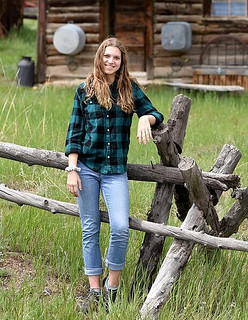 After eight and a half years of collecting, Abby Zechman's interest has narrowed on Large Cents and "Red Books." "I am 12 books short of a full date set of Red Books, and I enjoy picking up raw Large Cents when I find one that catches my eye at a show," said Zechman. "I am assembling a date set collection of Large Cents in nice condition, however I am always drawn to old beat up or counter stamped coppers – they have more of a story."
After eight and a half years of collecting, Abby Zechman's interest has narrowed on Large Cents and "Red Books." "I am 12 books short of a full date set of Red Books, and I enjoy picking up raw Large Cents when I find one that catches my eye at a show," said Zechman. "I am assembling a date set collection of Large Cents in nice condition, however I am always drawn to old beat up or counter stamped coppers – they have more of a story."
Zechman has already earned half of her Associate of Arts degree at Lake Sumter State College where she plans to finish before transferring to University of Central Florida to complete her Bachelor's degree in elementary education. Once complete, she intends to use her degree to work for the American Numismatic Association.
"I want to work in the education department teaching kids and others about numismatics," she said. "I have always had a passion for teaching and the ANA has had a huge impact on my life. I want to be part of that for future collectors and help keep our hobby alive."
Colin Feitl
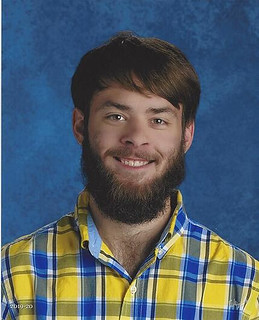 The second college recipient, Colin Feitl, has been collecting since he was a toddler – picking up coins wherever he found them – the beach, parking lot, sidewalks and more. In sixth grade he went to his first coin show and formally started several collections from there.
The second college recipient, Colin Feitl, has been collecting since he was a toddler – picking up coins wherever he found them – the beach, parking lot, sidewalks and more. In sixth grade he went to his first coin show and formally started several collections from there.
He plans to use his scholarship money at Northern Kentucky University, where he plans to study media informatics and business. While in college, he plans to return to Summer Seminar, attend the World's Fair of Money and remain active in his local club, the Cincinnati Numismatic Association.
"I also hope to get a decent job someday to allow me to grow my collections," he said. Today, he enjoys collecting Morgan Dollars, Ancient Roman Empire coins and modern Asian coins.
"Thanks to all who made this scholarship possible," Feitl said. " Once I delved into learning about numismatics, I just kept finding how much more there is to learn. I know most people my age are interested in money to be able to spend it but none who are interested in numismatics. I feel passionate about keeping the interest in the hobby and history of numismatics alive for the next generation so that it is not forgotten."
Applications for the 2021 ANA College Scholarship will be available in January. Recipients are selected based on academic scholarship, numismatic accomplishments and financial need. Applicants must be a senior in high school and a member of the ANA.
For additional information, contact Rod Gillis via email at gillis@money.org or call him at (719) 482-9845.
For more information, see:
ANA COLLEGE SCHOLARSHIP
(https://www.money.org/young-numismatists/college-scholarship)
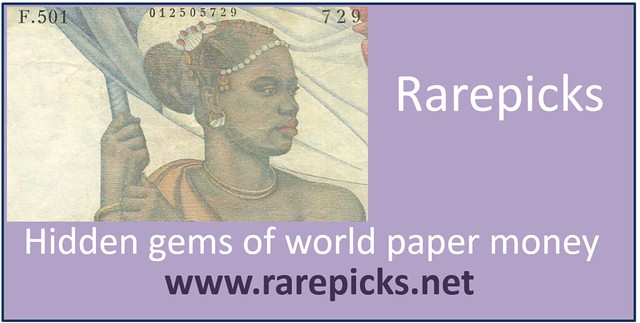
S.S. CENTRAL AMERICA TREASURES IN GOLDBERG’S SALE
Here is the press release about items recovered from the wreck of the S.S. Central America in the September 2020 Goldberg’s auction. -Editor
Treasure In Goldberg’s September 2020 Auction
Tied for finest known 1856-S dime, rare 1856-S/s quarter, miner’s gold dust and coins from fabled ship’s safe among highlights
Historic sunken treasure from the California Gold Rush recovered from the fabled S.S. Central America which sank in 1857 will be offered to the public for the first time in an auction to be conducted in September in Los Angeles, California and online by Ira & Larry Goldberg Auctioneers ( www.GoldbergCoins.com).

1856 S over s Quarter
"One of the important highlights is a major numismatic discovery from the legendary ship: an extremely rare 1856 San Francisco Mint Liberty Seated No Motto quarter-dollar with a large S mint mark punched over a small s. It was discovered in a canvas bag in the purser’s sealed iron box in the ship’s safe on the seabed more than 7,000 feet below the Atlantic Ocean’s surface,” said Dwight Manley, Managing Partner of the California Gold Marketing Group (CGMG).
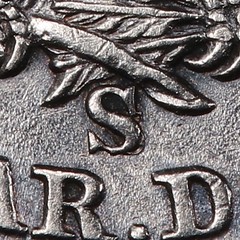 The 1856-S/s silver quarter now is graded PCGS XF45.
CGMG owns that coin and the other S.S. Central America treasure now being
offered for the first time in the Goldberg’s September 13 and 14, 2020 auction. "With a total mintage of only 286,000, ‘normal’ 1856-S quarter-dollars are scarce even in low, circulated grades, and extremely scarce in Mint State grade. The auction will include a recovered treasure 1856-S quarter graded PCGS MS63 CAC,” explained Larry Goldberg, auction house co-owner with his cousin Ira Goldberg.
The 1856-S/s silver quarter now is graded PCGS XF45.
CGMG owns that coin and the other S.S. Central America treasure now being
offered for the first time in the Goldberg’s September 13 and 14, 2020 auction. "With a total mintage of only 286,000, ‘normal’ 1856-S quarter-dollars are scarce even in low, circulated grades, and extremely scarce in Mint State grade. The auction will include a recovered treasure 1856-S quarter graded PCGS MS63 CAC,” explained Larry Goldberg, auction house co-owner with his cousin Ira Goldberg.
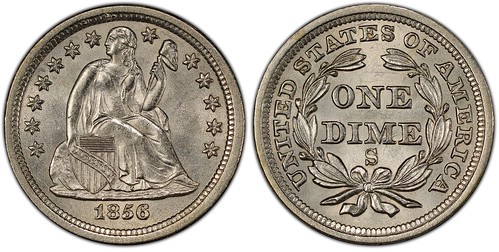
1856-S Lberty Seated dime PCGS MS65 CAC
"Another major highlight is an 1856-S Liberty Seated silver dime graded PCGS MS65 CAC and tied for the finest known,” said Manley. "Only 70,000 dimes – just $7,000 face value -- were minted in San Francisco in 1856 and a just handful are known today in uncirculated condition. This one’s a miracle survival coin, still pristine with full luster. It was displayed at the American Numismatic Association 2019 Chicago World’s Fair of Money.”
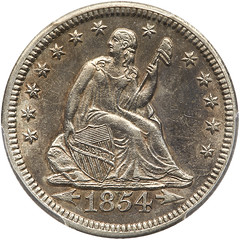

1854-O Huge O quarter dollar obverse
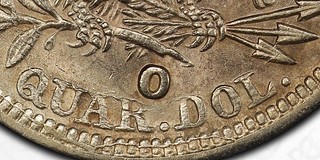 Also recovered from the ship and in the Goldberg’s September auction is a
scarce 1854-O Liberty Seated Arrows at Date silver quarter-dollar Huge Mint Mark variety. It is graded PCGS AU55 CAC and among the finest known of its kind.
Also recovered from the ship and in the Goldberg’s September auction is a
scarce 1854-O Liberty Seated Arrows at Date silver quarter-dollar Huge Mint Mark variety. It is graded PCGS AU55 CAC and among the finest known of its kind.
All the PCGS-certified treasure coins in the auction are housed in special encapsulation holders that include a pinch of miner’s gold dust also retrieved during the last recovery mission to the ship in 2014.
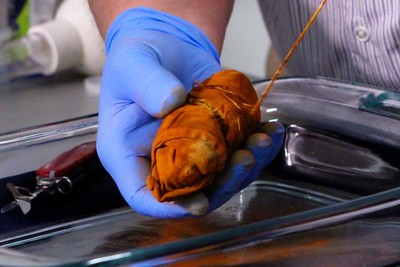
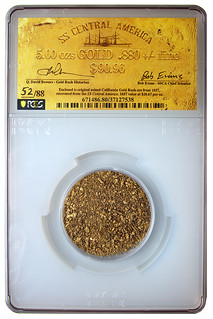
"This gold dust was originally discovered by 49ers during the heydays of the California Gold Rush and untouched in the miners’ gold field packets for more than 160 years,” explained Manley. "When it was recovered from the S.S. Central America the gold dust was still sealed in the miners’ original pokes, the satchels and pouches made of buckskin, canvas or leather.”
The sale also will include five ounces of recovered gold dust now housed in one of the 88 hand-numbered elegant, large-format holders specially prepared by PCGS. The insert label on the 5 1/2 by 9 inches holder is personally signed by the esteemed Q. David Bowers, author of two books about the Gold Rush and the SS Central America, and by Bob Evans, the chief scientist on the Ship of Gold sunken treasure recovery missions.
For additional information about the auction, visit Ira & Larry Goldberg Auctioneers online at www.GoldbergCoins.com or call 310-551-2646. The email address is info@GoldbergCoins.com.

2020 ANA INNOVATION DOLLAR NGC SLAB OFFERED
The Pennsylvania Association of Numismatists teamed up with Numismatic Guaranty Corporation® to offer a special sample slab for Innovation Dollars honoring Dr. Jonas Salk's polio vaccine. -Editor
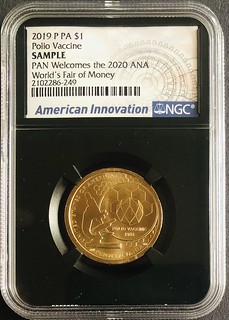 The August 4th – 8th ANA Convention cancellation disrupted plans that were already in place to enhance the weeklong event. The Pennsylvania Association of Numismatists made arrangements to host another "Welcome to Pittsburgh” dinner at the beautiful Le Mont Restaurant atop Mount Washington overlooking the fork of the Ohio River. Part of the attendee’s goodie bag was to include a custom label NGC holder 2019 Pennsylvania Innovation Dollar that ironically featured the 1953 discovery of the Polio Vaccine by University of Pittsburgh researcher Dr. Jonas Salk. NGC was to be a Platinum Sponsor of the dinner. The Covid-19 pandemic has created havoc across the globe and forced many cancellations and disruptions affecting everyone’s life today.
The August 4th – 8th ANA Convention cancellation disrupted plans that were already in place to enhance the weeklong event. The Pennsylvania Association of Numismatists made arrangements to host another "Welcome to Pittsburgh” dinner at the beautiful Le Mont Restaurant atop Mount Washington overlooking the fork of the Ohio River. Part of the attendee’s goodie bag was to include a custom label NGC holder 2019 Pennsylvania Innovation Dollar that ironically featured the 1953 discovery of the Polio Vaccine by University of Pittsburgh researcher Dr. Jonas Salk. NGC was to be a Platinum Sponsor of the dinner. The Covid-19 pandemic has created havoc across the globe and forced many cancellations and disruptions affecting everyone’s life today.
PAN has decided to make the 300 special label NGC slabs available to the public at $19.95 each (free shipping in the U.S.) The money raised will be used for numismatic education with a primary focus on young people and the PAN KidZone next scheduled for Saturday October 31st as part of the PAN Fall Coin Convention scheduled for October 29-31, 2020 at the Monroeville Convention Center, a Pittsburgh suburb. The Covid-19 situation this fall will determine if the PAN Coin Show will be able to take place.
The first 100 slabs will be given to the kids that attend. The children were the most affected by polio in the 1950’s and it is fitting today that we remember what parents and children went through at that time to keep safe. This will leave 200 slabs remaining for public sale. The PAN Board views this as a good way to dispose of these unique slabs and a good use of the proceeds generated by collector’s generosity in these unique times. Please consider this coin addition to your collection.
The Polio Vaccine NGC Innovation Dollars can purchased through the PAN website www.PANcoins.org or by mail $19.95 each, check payable to:
PAN
1985 Lincoln Way
Suite 23 #225
White Oak PA 15131

WOKEFIELD IRON AGE GOLD COIN FIND
A nice group of eight gold staters discovered in Wokefield, a town south of Reading, England has been published by the West Berkshire Museum. Found via The Explorator newsletter. To subscribe to Explorator, send a blank email message to: explorator+subscribe@groups.io. -Editor
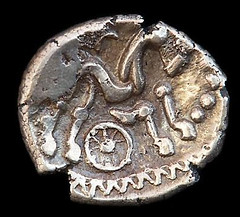 IN 2017, four metal detectorists were investigating an area in Wokefield parish, West Berkshire, when they discovered eight gold coins scattered over an area of approximately 30 square metres.
IN 2017, four metal detectorists were investigating an area in Wokefield parish, West Berkshire, when they discovered eight gold coins scattered over an area of approximately 30 square metres.
As experienced detectorists they knew that they had found a hoard and that it was probably Treasure, so they reported it to a portable antiquities scheme finds liaison officer, a legal requirement under the Act. The coins were very unusual and were identified as ‘Selsey Two-Faced’ staters, dated to 60-20 BC. Each of the coins depicts a three-tailed horse, a high status symbol in the Iron Age, on one side and a wide variety of faces, figures and symbols on the reverse, including a charioteer’s arm, a chicken and a stylised stalk of wheat or barley.
In the late Iron Age coins were minted by local tribes, but their usage was generally restricted to high status individuals. These gold coins were issued by the local Regini and Atrebates tribes, the Atrebates’ capital, Silchester, being only a few miles to the south. They are approximately 18mm in diameter and each weighs about 6g. The coins are a significant find as very little Iron Age material has been recorded in Wokefield.
After the coins were declared Treasure, West Berkshire Museum acquired them with support from Art Fund, Wokefield Parish Council and Mary Buxey, a former member of the Newbury District Field Club. The coins are on display in the museum as part of the Hoards Exhibition and can be seen again now the museum is reopened on Wednesdays to Fridays, 10am to 4pm.
To read the complete article, see:
What a find! West Berkshire hoard of 8 gold Iron Age coins
(https://www.newburytoday.co.uk/news/out---about/31343/what-a-find-west-berkshire-hoard-of-8-gold-iron-age-coins.html)
COINAGE OF THE EMPRESS IRENE
A recent article in Mike Markowitz's CoinWeek Ancient Coin Series discusses the Byzantine Empress Irene. Here's an excerpt, but be sure to read the complete article online. -Editor
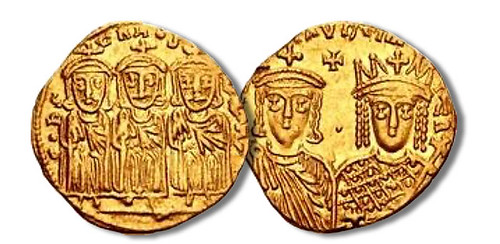
Constantine VI & Irene, with Leo III, Constantine V, and Leo IV. 780-797. AV Solidus (19.5mm, 4.38 g, 6h). Constantinople mint. Struck 790-792. Constantine V, Leo III, and Leo IV seated facing, each crowned and draped / Crowned facing busts of Constantine VI, draped and holding globus cruciger, and Irene, wearing loros and holding globus cruciger and cruciform scepter; cross above, • between. DOC 1; SB 1593. Good VF. Classical Numismatic Group Auction 114, 13 May 2020, Lot: 1050. Price realized: 2,750 USD.
ATHENS IN THE eighth century was a provincial small town living on memories of past glories. But its aristocrats were proud of their daughters, reputedly the most talented and beautiful women in the Eastern Roman ("Byzantine”) empire. When Emperor Constantine V needed a bride for his son and heir, the future Leo IV (ruled 770-775) a 15-year-old Athenian girl named Irene (Eirene in Greek) was chosen. Shrewd and ruthless, she became the first woman to rule this fiercely masculine empire in her own right.
Her coinage is eagerly collected today.
Dynastic solidus
On September 8, 780, Leo IV died at the age of 31. Irene then became regent for her nine year-old son, Constantine VI. A gold solidus celebrates dynastic continuity; on the obverse three generations of deceased ancestors sit side by side: Leo III, Constantine V and Leo IV. Irene and her son appear on the reverse. She wears the imperial crown with triangular points and dangling strings of pearls (pendilia) that indicated "empress” to Byzantines.
To read the complete article, see:
Byzantine Coinage of the Empress Irene – CoinWeek Ancient Coin Series
(https://coinweek.com/ancient-coins/byzantine-coinage-of-the-empress-irene-coinweek-ancient-coin-series/)
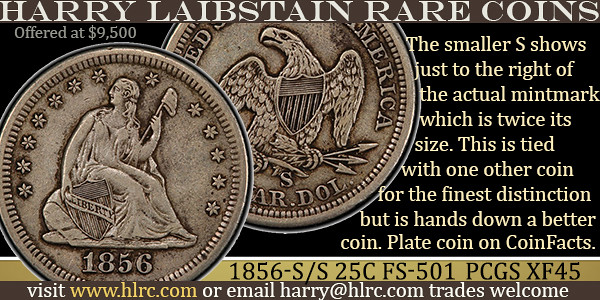
WAYNE'S NUMISMATIC DIARY: JULY 26, 2020
The coronavirus pandemic has shut down most public gatherings, and it has been months since we've held a dinner of my Northern Virginia numismatic social group Nummis Nova. This week we held our first video meeting via Zoom thanks to the sponsorship and emceeing of member Aaron Packard. Attendees included Aaron and myself, Mike Packard (no relation), Joe Esposito, Julian Leidman, Tom Kays, and Bill Eckberg attending from his retirement haven of West Palm Beach, FL.
It was nice to "see" everyone again onscreen. The video and audio worked pretty well once we got past some initial hurdles. We've already made plans to hold another one next month.
The format was basically an online show and tell. While we were addressing some technical issues I gave an overview of the now-defunct ANA Edition of The E-Sylum and noted how former ANA readers were piling in to subscribe to the regular Sunday night issue. We added several new subscribers during the course of the evening.
Bill Eckberg
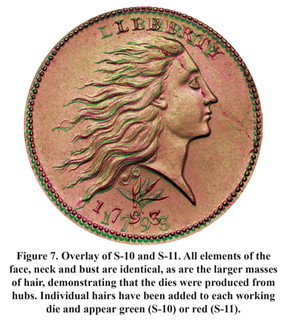 Bill was first up, discussing his recent research into die making at the early U.S. Mint. Some of his work was recently published in Penny-Wise and The Numismatist, with follow-up articles planned for the same publications. Bill, a retired scientist, used observation and technology to investigate how engravers reused their designs on differently sized coins to both save time and keep a similar look for multiple denominations. His tools include PhotoShop and special software for comparing two different images.
Bill was first up, discussing his recent research into die making at the early U.S. Mint. Some of his work was recently published in Penny-Wise and The Numismatist, with follow-up articles planned for the same publications. Bill, a retired scientist, used observation and technology to investigate how engravers reused their designs on differently sized coins to both save time and keep a similar look for multiple denominations. His tools include PhotoShop and special software for comparing two different images.
To read an earlier E-Sylum article, see:
THE COINS TELL THEIR STORY BEST
(https://www.coinbooks.org/v23/esylum_v23n19a24.html)
Joe Esposito
Joe was next, discussing a few items from his library including a Green's Checklist bought from the Armand Champa library sale, and a 1795 first edition of Virtuoso's Companion, an early book on British merchant tokens. Coincidently, I had just read a contemporary Gentleman's Magazine review of the later 1798 edition; I've been working to compile for the Newman Numismatic Portal a database of numismatic articles in non-numismatic publications.
Tom Kays
Tom had prepared a group of photos of members taken at our events over the years, but due to some technical difficulties it was decided to save this discussion for our next video conference.
Wayne Homren
I used my "show-and-tell" segment to discuss four items that are part of my recent consignment to Stack's Bowers Galleries. These will appear in their August sales. Not a headline-worthy consignment, it's an accumulation of disparate material acquired over many years. Time to make space in the safe deposit box and raise some cash for our kids' college fund. If you see something you like, please be sure to bid!
Lesher House Restoration Souvenir Dollar


"1900" (1985) Lesher House Restoration Souvenir. Silver. No. 105. Mint State.
35 mm. 31.2 grams. One thousand of these were issued by the American Numismatic Association to raise funds to restore the original Lesher House in Victor, Colorado.
My one and only Lesher Dollar. This was a commemorative souvenir issue given to those of us who contributed to an ANA fundraising campaign to restore the home of Joseph Lesher. Very nicely done, it's a great piece for collectors of Lesher dollars, so-called dollars in general, private and pioneer coinage or ANA medals. It's a low number to boot.
To read the complete lot description, see:
"1900" (1985) Lesher House Restoration Souvenir. Silver. No. 105. Mint State.
(https://auctions.stacksbowers.com/lots/view/3-NM4TW/1900-1985-lesher-house-restoration-souvenir-silver-no-105-mint-state)
Stone &Ball Counterstamps on Liberty Seated Quarters
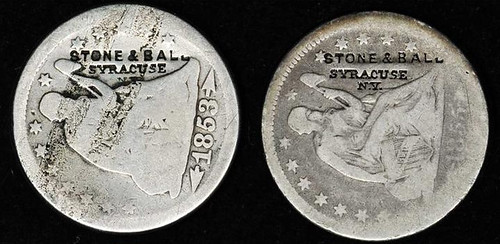
New York--Syracuse. STONE & BALL / SYRACUSE / N. Y. on 1853 and 1855 Liberty Seated quarters. Brunk S-1023, Rulau NY-1027D.
Host coins are Good to VG, with PVC residue.
Provenance: From our (American Numismatic Rarities') Lake Michigan & Springdale Collections sale, June 2006, lot 899. Lot tag included.
Part of my consignment consists of some leftover lots from the 2006 American Numismatic Rarities sale of my Civil War and merchant counterstamp collections. Here's a nice pair of Stone & Ball stamps on Liberty Seated quarters.
To read the complete lot description, see:
New York--Syracuse. STONE & BALL / SYRACUSE / N. Y. on 1853 and 1855 Liberty Seated quarters. Brunk S-1023, Rulau NY-1027D.
(https://auctions.stacksbowers.com/lots/view/3-NM4UQ/new-york-syracuse-stone-ball-syracuse-n-y-on-1853-and-1855-liberty-seated-quarters-brunk-s-1023-rulau-ny-1027d)
1859 Augustus B. Sage Store Card
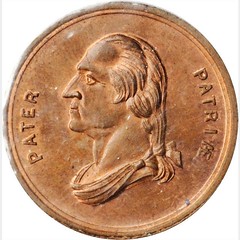

1859 A.B. Sage & Co. Store Card. Musante GW-334, Baker-572A, Miller-NY 762A. Copper. Plain Edge. Thick Planchet. Mint State.
This one looks much nicer in person than the photos. Julian and others immediately asked if I'd tried conserving it to remove the residue from the old holder. I hadn't, and sure wish I had before sending this in. Great piece for numismatic biblophiles and students of U.S. numismatic history.
To read the complete lot description, see:
1859 A.B. Sage & Co. Store Card. Musante GW-334, Baker-572A, Miller-NY 762A. Copper. Plain Edge. Thick Planchet. Mint State.
(https://auctions.stacksbowers.com/lots/view/3-NM4U8/1859-ab-sage-co-store-card-musante-gw-334-baker-572a-miller-ny-762a-copper-plain-edge-thick-planchet-mint-state)
Rare Cast Allegheny City Communion Token
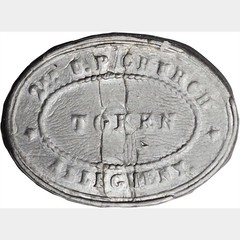

Pennsylvania--Allegheny City. 2nd U. P. Church. Original Dies. Lead. Very Fine.
19 mm x 25 mm, oval. 8.5 grams. An earlier cast token, unlike the die struck examples in the previous two lots. Not listed in Bason. After review, Mrs. Bason assigned this variety number 186A.
For more information, see The Communion Tokens of the Second United Presbyterian Church of Allegheny, Pennsylvania by Wayne K. Homren and Lawrence C. Dziubek in TAMS Journal, June 1993, p82-85.
https://nnp.wustl.edu/library/book/525517?page=12
World communion tokens are generally common, but U.S. communion tokens are quite rare. I was fortunate to come into possession of a small group of communion tokens from the 2nd United Presbyterian Church of Allegheny City. Allegheny City was a separate town at the time, but was later annexed to the City of Pittsburgh, known today as "the North Side", home to the sports stadiums of the Pittsburgh Steelers and Pittsburgh Pirates.
I culled through the group and kept the best. With the invaluable help of fellow Western Pennsylvania Numismatic Society member Larry Dziubek we published an article about the tokens in the TAMS Journal. This particular token is quite interesting. While most of the known pieces are die struck, earlier examples were cast in lead. These rare cast varieties were not listed in the standard reference by Autence Bason. We corresponded with her and she assigned a new variety number for these pieces.
To read the complete lot description, see:
Pennsylvania--Allegheny City. 2nd U. P. Church. Original Dies. Lead. Very Fine.
(https://auctions.stacksbowers.com/lots/view/3-NM4TT/pennsylvania-allegheny-city-2nd-u-p-church-original-dies-lead-very-fine)
Did I mention this is for the college fund? Be sure to bid if you have any interest in these lots. Thanks!
It was an enjoyable session. I'm looking forward to the next one almost as much as I'm looking forward to the day when we can resume our monthly dinners.

TRUMP PRESIDENTIAL MEDAL DESIGNS RECOMMENDED
The CCAC and CFA have recommended designs for the Trump Presidential Medal. -Editor

Designs for the Donald J. Trump Presidential Medal have been recommended by the Commission of Fine Arts (CFA) and by the Citizens Coinage Advisory Committee (CCAC).
After the final designs are officially selected, the United States Mint will eventually transfer them onto bronze and silver medals and offer them for sale to the public. The U.S. Mint produces Congressional and numerous list medals, and has been tasked with striking Presidential medals in bronze since the early days of the nation. In 2018, the Mint also started making Presidential silver medals which shared designs from the earlier issued Presidential bronze medals.
The U.S. Mint submitted 34 proposed Trump Presidential medal designs with splits of 10 candidates for the medal’s obverse (heads side) and 24 candidates for the medal’s reverse (tails side). The CFA reviewed all 34 designs on June 18 while the CFA reviewed them on June 23.
Consistent with the preferences of the White House liaison, both the CFA and CCAC recommended obverse #1 and reverse #10.
Each obverse candidate depicts a likeness of the president. Recommend obverse design #1 also shows an inscription of "DONALD J. TRUMP."
Recommended reverse design #10 features images of the Presidential seal and of the White House, inscriptions "THE FORGOTTEN MEN AND WOMEN OF OUR COUNTRY WILL NOT BE FORGOTTEN AGAIN" for a portion of Trump’s inaugural address and "JANUARY 2020, 2017" for Trump’s inauguration date, and 45 encirculating stars denoting Trump as the 45th President of the United States.
See the full article online for a view of all the candidate obverse and reverse designs. -Editor
To read the complete article, see:
Donald Trump Presidential Medal Designs Recommended
(https://www.coinnews.net/2020/07/24/donald-trump-presidential-medal-designs-recommended/)
TRUMP-REAGAN FUNDRAISING COIN KERFUFFLE
Meanwhile, a Trump fundraising effort has triggered a spat between the campaign and the Ronald Reagan foundation. -Editor
President Trump lashed out at the Ronald Reagan Presidential Foundation and Institute on Sunday following a report that it had requested the Trump campaign stop using President Reagan's name and image in fundraising.
The organization made its request last week after the Trump campaign had sent an email asking for a donation of $45 or more to enter to receive a "limited edition” set of two gold-colored coins that had images of Trump and Reagan.
Reagan Foundation Chief Marketing Officer Melissa Giller told The Hill Saturday that the RNC had used Reagan’s image "without our consent” despite the foundation owning the rights to it.
Michael Ahrens, the RNC's communications director, told The Hill that the foundation had "just recently hosted the Trump family to raise money for its organization and has not objected to us using President Reagan’s likeness before." But he said the RNC will stop "emailing this fundraising solicitation as a courtesy."
To read the complete article, see:
Trump lashes out at Reagan Foundation over fundraising request
(https://thehill.com/homenews/administration/509096-trump-lashes-out-at-reagan-foundation-fox-news)
The Washington Post, The Guardian and others published articles on this too, but I'm still looking for decent images of the subject Trump-Reagan "coin". Has anyone seen one? The closest thing I've found is this image of Trump campaign marketing material from The Guardian. -Editor

To read the complete articles, see:
Reagan Foundation to Trump, RNC: Quit raising money off Ronald Reagan’s legacy
(https://www.washingtonpost.com/opinions/2020/07/25/reagan-foundation-trump-rnc-quit-raising-money-off-ronald-reagans-legacy/)
Trump aims barb at Reagan Foundation in fundraising coin kerfuffle
(https://www.theguardian.com/us-news/2020/jul/26/trump-reagan-foundation-fundraising-coins-washington-post)

THE FIVE UNIQUE SPEELMAN-WHITE UNCUT SHEETS
In their July 16, 2020 Currency News email newsletter, Heritage Auctions published a nice writeup on the five unique Speelman-White uncut sheets being offered in their upcoming August 3, 2020 sale. Great notes! -Editor
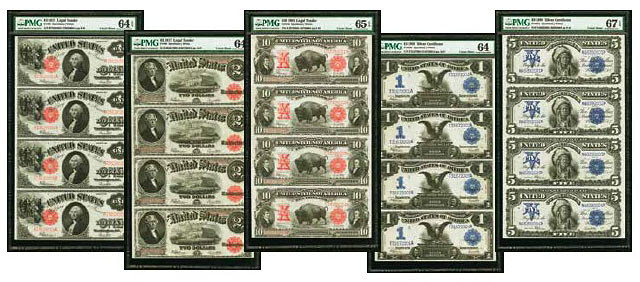
From July 1885 through the middle of 1910, the Bureau of Engraving and Printing delivered all notes to the Treasury Department in the form of uncut sheets, to be separated at the Treasury. Prior to that, and once again starting in June 1910 continuing to the present, the BEP delivered notes to the Treasury fully printed and separated. During those periods, Treasury officials would need to have made a special request to the BEP to obtain uncut sheets.
The Bureau of Engraving and Printing still possesses Treasury Department ledgers and indices recording the note deliveries from the BEP to the Treasury. These records are of particular interest here because they document the first step in the remarkable provenance of the five unique Speelman-White uncut sheets now being offered in Heritage Auctions' August 3rd ANA Platinum Night auction at our world headquarters in Dallas.
Specifically, the ledger entry for August 30, 1923 details the receipt by the Treasury of $1 Legal Tender Notes with Serial Numbers R73512001A through R73992000A, and mentions that the sheet with numbers R73628001A through R73628004A was transferred to the Treasury uncut, with the red notation, "H. V. Speelman." This is the uncut sheet we are offering in our August 3rd auction #3578. Similar references in the ledgers can also be found for the $2 Legal Tender sheet, the $10 Legal Tender sheet, the $1 Silver Certificate sheet, and the $5 Silver Certificate sheet also appearing in this remarkable sale.
 These five unique uncut sheets, all delivered to Register of the Treasury, Harley V. Speelman, within a short period in late 1923, have remained together to this day. After Speelman, their trail is next picked up in the late 1950s, when John J. Ford, Jr. obtained them from the F. C. C. Boyd estate and sold them to Oscar G. Schilke. From there, they went through Ben Levin, Stanley Kesselman, and two anonymous collectors, before they were acquired by Herman Halpern in 1991. It is believed, but cannot be proven, that they were obtained from Speelman by Wayte Raymond for Col. E. H. R. Green, whose estate was appraised by F. C. C. Boyd. Since Boyd, as the estate appraiser could not legally buy from the estate, he is known to have been given items from the estate for his fee.
These five unique uncut sheets, all delivered to Register of the Treasury, Harley V. Speelman, within a short period in late 1923, have remained together to this day. After Speelman, their trail is next picked up in the late 1950s, when John J. Ford, Jr. obtained them from the F. C. C. Boyd estate and sold them to Oscar G. Schilke. From there, they went through Ben Levin, Stanley Kesselman, and two anonymous collectors, before they were acquired by Herman Halpern in 1991. It is believed, but cannot be proven, that they were obtained from Speelman by Wayte Raymond for Col. E. H. R. Green, whose estate was appraised by F. C. C. Boyd. Since Boyd, as the estate appraiser could not legally buy from the estate, he is known to have been given items from the estate for his fee.
In March 1993, for the first time, the sheets were offered individually in a Stacks sale. Fortuitously, all five sheets were acquired by our present consignor, keeping them together for another 27 years. On August 3rd, at Heritage Auctions' own ANA Platinum Night auction in Dallas, they are once again being offered individually to afford as many collectors as possible the opportunity to acquire one of these unique pieces of history. We owe Mr. Speelman a debt of gratitude for his foresight in preserving these numismatic treasures for us all to enjoy today.

GRINNELL SERIES 1914 AND 1918 FRN PROOFS
There's an even more remarkable group of notes in the August Heritage sale. Also described in the July 16, 2020 Currency News email newsletter are the crowning gems of the legendary Albert Grinnell paper money collection, a binder of eighteen individual Proofs of Series 1914 and 1918 Federal Reserve notes of each denomination. Amazing! -Editor
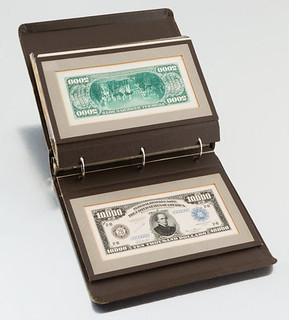 There is a saying that old paper money offers the opportunity to hold history in your hands. This fantastic group of Proofs is perhaps the most outstanding example of that concept known in the field of paper money collecting today. This unique set comprises both face and back Proofs of Series 1914 and 1918 Federal Reserve notes of each denomination: $5, $10, $20, $50, $100, $500, $1000, $5000, and $10,000, all housed in a specially prepared, custom binder.
There is a saying that old paper money offers the opportunity to hold history in your hands. This fantastic group of Proofs is perhaps the most outstanding example of that concept known in the field of paper money collecting today. This unique set comprises both face and back Proofs of Series 1914 and 1918 Federal Reserve notes of each denomination: $5, $10, $20, $50, $100, $500, $1000, $5000, and $10,000, all housed in a specially prepared, custom binder.
On December 23, 1913, President Woodrow Wilson signed into law the Federal Reserve Act, which transformed the American monetary system. Throughout the next year, various prototype designs were produced and considered, until a standardized design was finalized in the fall of 1914. As a part of the design process, a small quantity of Proof examples was produced. These Proofs were printed from the actual currency plates onto card stock. The Treasury seal and the all zero serial numbers were glued on by hand by the pressman. Though the 1916 Annual Report of the Bureau of Engraving and Printing noted two sets of the $5 to $100 denominations produced, we know of additional (perhaps five) sets of Series 1914 Proofs that were presented by Secretary of the Treasury, William G. McAdoo, to a select group of officials in late 1914.

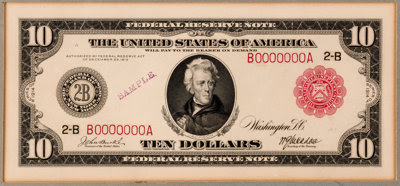
When the Federal Reserve became a better facility for banks to transfer large amounts of cash, the larger denominations were ideal. The Series 1918 Federal Reserve Notes were printed only in the $500, $1,000, $5,000, and $10,000 denominations. In the design process, Proofs were prepared for each of the denominations above. This is where the historical significance of this set ultimately lies.
By 1926, the process for handling Proofs included rules for mandatory destruction of the items, preventing additional Proofs from being distributed outside the Bureau. While Specimen were still printed and distributed, these may be the last Proofs to have made their way out of the Bureau of Engraving and Printing, as none of the Series 1923 notes have appeared in any Proof form.
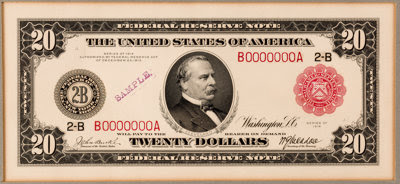
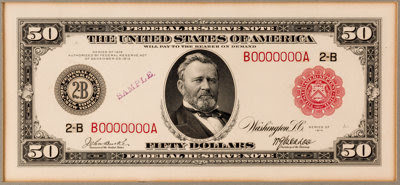
The binder with its eighteen individual Proofs, traces its history back to none other than Albert Grinnell, who acquired this phenomenal set of Proofs presumably from one of his friends and contacts within the Treasury Department. This set was the highlight of the entire seven-part Grinnell Collection sale conducted by Barney Bluestone. This grouping appeared in Part VI of the sale on June 29, 1946 as Lot 4871, and turned out to sell for a higher price than any of the other 5,897 lots in the entire seven-part sale. Since then, some of Grinnell's other notes have gone on to realize well into seven figures at auction in the last decade, including a Grand Watermelon, which currently tops the list of most expensive banknotes ever sold at auction, realizing $3,290,000 in our 2014 FUN Signature Auction.
Bluestone took the opportunity to detail Mr. Grinnell's great pride in owning this set when he wrote in the catalog, "I can remember when Mr. Grinnell showed me his collection several years ago, that he reserved this lot of specimens, or engraver's impressions, until the very end. He felt that it was the crowning masterpiece of his successful achievement as a collector, and a fitting climax to his extensive and magnificent collection. He was respectably and justly proud of this possession and valued it highly." What Bluestone wrote next is as applicable today as it was in 1946: "Without doubt, this is a prize that will bring much joy to the heart of some collector. It is unique and, as stated previously, I do not believe its companion exists."

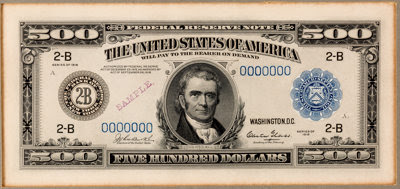
After selling for $4,050 in 1946, the grouping has made several public auction appearances, including Coins & Currency's August 7, 1969 sale, lot 1760; Forman & Taxay's December 6, 1974 sale, lot 250; New England Rare Coin Auction's March 26, 1976 sale, lot 9; NASCA's Brookdale Collection November 12, 1979 sale, lot 2230; and Stack's J.W. Thompson March 14, 1991 sale, lot 2136.
The Notes
All of the Proofs appear to be on both sides of the cardstock, although previous examples of similar notes have been uniface. The notes are printed on cardstock, and mounted in custom 6-1/2" x 9-1/2" frames that have been sealed on all four sides and fitted in a special leather binder that is believed to be contemporary to Grinnell. While these notes have not been graded, we believe that these notes will easily be seen as as-printed Gem New examples.
The lower denomination notes ($5 through $100) are series 1914 Red Seal designs from the New York District. The black ink plate was used in each case to produce the base face impression with the red serial numbers and Treasury seal, and the black District seal and District number (2-B), all pasted in place. The serial number is B0000000A in each case. The engraved signatures are those of Burke and McAdoo. Both the face and back designs are the same as was used for production notes. All notes have SAMPLE stamped on the face.
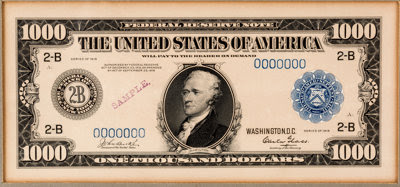

The higher denomination notes ($500 through $10,0000) are series 1918 Blue seal designs from the New York District. Again, the face Proofs were produced using the black ink plate to produce the basic face impression, with the blue Treasury seal, black District seal, black District number (2-B), and blue serial number (0000000) pasted in place. The engraved signatures are of Burke and Glass. All of the face and back designs are like those used for production. All notes have SPECIMEN stamped on the face.
Examined in entirety, the notes are far better preserved than any of the other large size Federal Reserve Proofs in collector circles. Greater care seems to have been taken in the printing, cutting, and application of the seals and serial numbers, all of which have much bolder impressions and richer colors than the examples in other sets.
While the aforementioned sets of $5 to $100 Red Seals presented by McAdoo are undeniably historically valuable and rare, it is the Blue Seal high denomination notes crowning this set that ensure that this is unquestionably the most important set of Proof notes in United States monetary history. The $500 and $1000 values are, of course, rare and difficult to acquire, but the $5000 and $10,000 are only collectable as part of this set. There are no examples of either denomination in private hands. The five examples of each outstanding denomination have been ensconced in either the Smithsonian or in one of the Federal Reserve Bank collections. The remarkable history, unique $5,000 and $10,000 impressions, and previous record setting prices realized, have established this set as one of America's most notable rarities in all of numismatics.
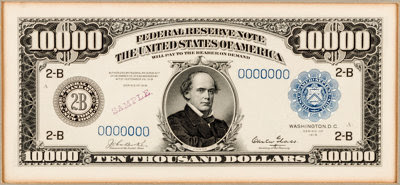

COSTA RICA ISSUES NEW POLYMER BANKNOTES
Costa Rica has issued a new series of polymer banknotes. -Editor
The Banco Central de Costa Rica (Central Bank) will put into circulation a new denomination of banknotes similar to the material used in the ¢1.000 notes currently in circulation.
The new notes are made of a polymer substrate, a compound similar to plastic, but which makes it recyclable. This material makes the notes more resistant and durable and will allow the material to be reused when they reach their useful life.
The new banknotes will be similar in size, shape and color of the notes currently in circulation, just they will have a different feel. They are ¢20MIL, ¢10MIL, ¢5MIL, and ¢2MIL.
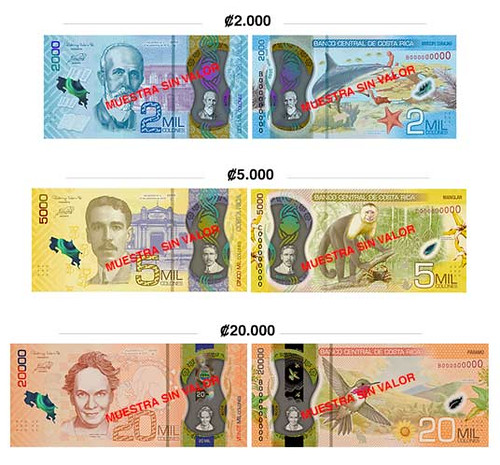
"Although the new banknotes have adjustments in their design and in their structure of security measures to verify their authenticity and combat counterfeiting, they maintain the same characters, motifs, shades and sizes as those currently in circulation,” said the Central Bank.
The new notes will be hitting the streets in "the coming months” according to the Central Bank.
The ¢50MIL is being taken out of circulation. The others will continue in circulation until final withdrawal, a date for this is not yet defined.
To read the complete article, see:
The New Costa Rica Banknotes
(https://qcostarica.com/the-new-costa-rica-banknotes/)

INDIAN INDEPENDENCE BRITISH NOTE COUNTERFEITS
This article from Al Jazeera mentions a British banknote counterfeiting scheme in India. I'm not familiar with this - can anyone provide more information? Are any of these notes in collector hands, like the Operation Bernhard Nazi counterfeits? Here's an excerpt. -Editor
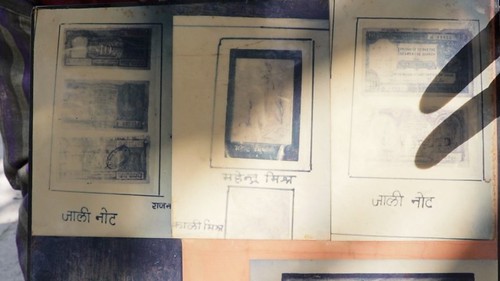
Most people know Mahendra Mishra (or Misir) as a noted folk singer from the region, credited with popularising the Poorvi genre of Bhojpuri music, which also includes Kajri, Baramasa, Jatsaar and Chait, popular in parts of Bihar and neighbouring Uttar Pradesh state.
But few are aware that Mishra also ran a clandestine operation in the first half of the 20th century, printing fake currency notes to fund the freedom fighters leading the struggle for India's independence from the British colonial rulers.
Mishra started printing fake currency notes around 1915 to fund the revolutionaries from Bihar and Kolkata, and aid their efforts to liberate India.
"He was selfless and didn't use any of the money for himself, else he would have been living in a mansion of silver. He left behind no bank balance, no assets. It explains why his family still lives in a modest house and survives on the meagre income generated from agriculture," Ajay adds.
Mishra continued to print fake currency notes for nearly four years until the British got wind of his clandestine activities.
To read the complete article, see:
Indian folk icon who also printed fake notes to fight the British
(https://www.aljazeera.com/indepth/features/indian-folk-icon-printed-fake-money-fight-british-200707103800167.html)

THE NEW YORK FEDERAL GOLD VAULT
Pablo Hoffman passed along this Atlas Obscura piece about the gold vault at the New York Federal Reserve Bank. Thanks. He adds, "These bars can get you intoxicated, but not drunk . . . " -Editor
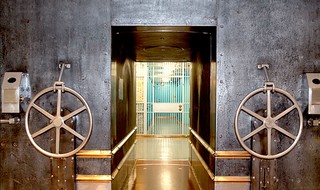 THE LARGEST ACCUMULATION OF GOLD in human history is located deep underneath the heart of Manhattan’s financial district, at the New York Federal Reserve Bank. Some 80 feet beneath sidewalk level, the Fed’s special vault is built into the bedrock and entrusted with deposits from central banks across the globe. Inside sits 7,000 tons of glittering gold bars—around 5 percent of all of the gold ever mined.
THE LARGEST ACCUMULATION OF GOLD in human history is located deep underneath the heart of Manhattan’s financial district, at the New York Federal Reserve Bank. Some 80 feet beneath sidewalk level, the Fed’s special vault is built into the bedrock and entrusted with deposits from central banks across the globe. Inside sits 7,000 tons of glittering gold bars—around 5 percent of all of the gold ever mined.
The only way into the vault is via a cylindrical entryway that rotates at the turn of a wheel. A sliver-shaped pie chunk of the cylinder has an opening, and when properly aligned with the entry hallway allows access to the treasure inside. Inside there are 122 separate mini-vaults (one for every country), plus a "library vault” for account holders with smaller deposits.
The Fed considers each gold bar to be non-fungible and unique because of variations in purity and weight. As a result, they carefully track each of the deposits, so if you give them a particular bar you can later retrieve that exact one.
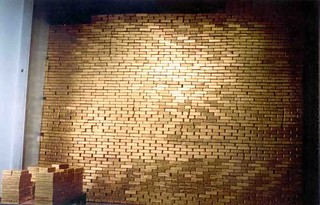 The Fed’s gold vault doesn’t cater to millionaires and billionaires, though; its customers are sovereign nations. While the list of accountholders is a closely guarded secret, state-run banks like Bank of England, Banque de France, and Deutsche Bundesbank are likely clients. Foreign countries store their gold in New York because it’s a convenient and central location. One of the perks of a central deposit location is that countries can transfer gold amongst themselves by simply ordering bars to be transferred from one compartment to another at a modest handling cost of $2 per bar.
The Fed’s gold vault doesn’t cater to millionaires and billionaires, though; its customers are sovereign nations. While the list of accountholders is a closely guarded secret, state-run banks like Bank of England, Banque de France, and Deutsche Bundesbank are likely clients. Foreign countries store their gold in New York because it’s a convenient and central location. One of the perks of a central deposit location is that countries can transfer gold amongst themselves by simply ordering bars to be transferred from one compartment to another at a modest handling cost of $2 per bar.
Perhaps the most amazing thing about the New York Federal gold vault is that it offers public tours (although the website says that new bookings are currently unavailable). That’s remarkable, considering the security at similar facilities like the Gold Bullion Depository at Fort Knox, which "bars” the likes of reporters, members of congress, and even former presidents.
To read the complete article, see:
New York Federal Gold Vault
(https://www.atlasobscura.com/places/new-york-federal-gold-vault)
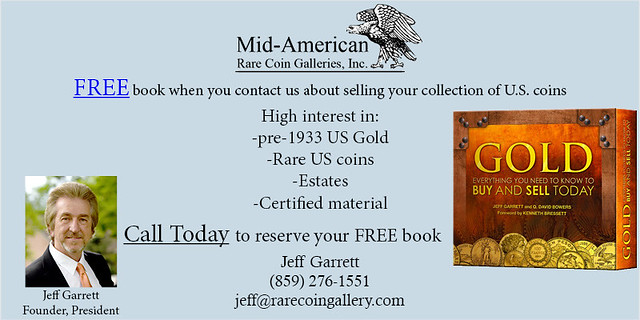
LOOSE CHANGE: JULY 26, 2020
Here are some additional items in the media this week that may be of interest. -Editor
CoinWeek Podcast: 1822 $5 vs. the 1870-S $3
The July 23, 2020 CoinWeek Podcast features a showdown between two legendary U.S. rarities. -Editor
 It’s a battle of epic proportions today on the CoinWeek Podcast, as noted gold coin expert and author Doug Winter and I pit two multi-million dollar coins head to head to find out which great American rarity comes out on top.
It’s a battle of epic proportions today on the CoinWeek Podcast, as noted gold coin expert and author Doug Winter and I pit two multi-million dollar coins head to head to find out which great American rarity comes out on top.
Our competitors are the 1822 half eagle and the 1870-S three-dollar gold coin.
Which of these coins will come out on top? You’re about to find out next, on the CoinWeek Podcast.
To read the complete article, see:
CoinWeek Podcast #138: Rare Coin Battle: The 1822 $5 Gold Coin vs. the 1870-S $3 Gold Coin
(https://coinweek.com/coins/million-dollar-items/coinweek-podcast-138-rare-coin-battle-the-1822-5-gold-coin-vs-the-1870-s-3-gold-coin/)
Stamps and Spies
From the Foreign Policy web site War on the Rocks is this article about how U.S. stamp designs have been influenced by spymasters such as CIA Director Allen Dulles. Non-numismatic, but interesting reading nonetheless. Have coin and banknote designs been similarly guided? -Editor
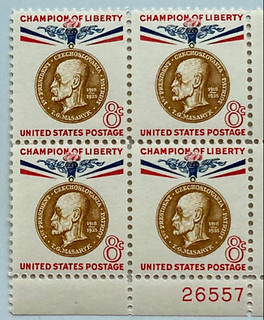 Art, literature, and music were all means by which the United States tried to portray itself as more culturally refined than, and therefore superior to, the Soviet Union during the Cold War. While the CIA’s covert funding of cultural front organizations has received a lot of attention, declassified U.S. government documents reveal that the designs of the ‘Champions of Liberty’ series and other Cold War-era stamps were similarly co-opted by the nation’s top intelligence and military officials.
Art, literature, and music were all means by which the United States tried to portray itself as more culturally refined than, and therefore superior to, the Soviet Union during the Cold War. While the CIA’s covert funding of cultural front organizations has received a lot of attention, declassified U.S. government documents reveal that the designs of the ‘Champions of Liberty’ series and other Cold War-era stamps were similarly co-opted by the nation’s top intelligence and military officials.
In the United States, proposals for stamp designs are evaluated by members of the Citizens’ Stamp Advisory Committee appointed by the postmaster general. The original founding committee in 1957 consisted of seven members: three philatelists (people who study stamps), three artists, and one representative from the U.S. Information Agency, then the lead institution for public diplomacy. This representative, Deputy Director Abbott Washburn, attended monthly meetings of the stamp committee. At the same time, he or his boss attended meetings of the Operations Coordinating Board of the National Security Council. This unique arrangement gave the U.S. government a valuable tool in its communication arsenal.
After the Soviet Union issued an ultimatum demanding the withdrawal of Western armed forces from West Berlin, the Operations Coordinating Board recommended issuing a stamp symbolizing the U.S. commitment to the divided city on the front lines of the Cold War.
To read the complete article, see:
STAMPS AND SPIES: THE CIA’S INVOLVEMENT IN POSTAGE DESIGN
(https://warontherocks.com/2020/07/stamps-and-spies-the-cias-involvement-in-postage-design/)
PLAYFUL ORIGAMI USING BANKNOTES
This article from The Guardian highlights some fun origami using banknotes from Japanese illustrator Yosuke Hasegawa. -Editor
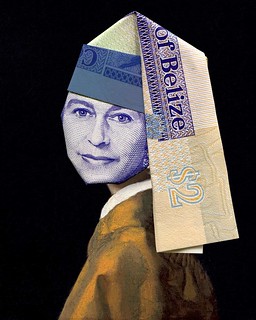 Playful origami using banknotes – in pictures
Playful origami using banknotes – in pictures
Yosuke Hasegawa has been making "money origami” for the past 14 years. The artist, who is based in Taiwan, has created hundreds of artworks out of banknotes from all over the world, each piece using an improvised technique.
"I take an image of a rigid historical person and change them into something cute and funny,” he says.
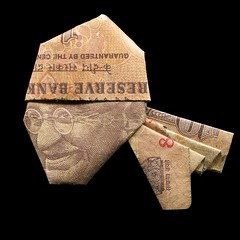

To read the complete article, see:
Playful origami using banknotes – in pictures
(https://www.theguardian.com/artanddesign/gallery/2020/jul/25/playful-origami-using-banknotes-in-pictures)
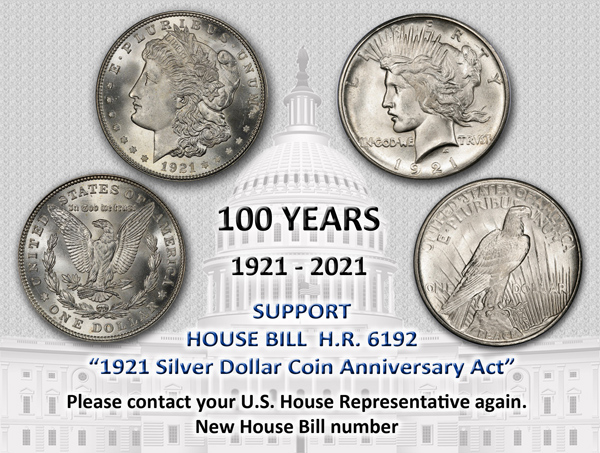
FEATURED WEB PAGE: LATIN AMERICAN BANKNOTE MAPS
This week's Featured Web Page is an article by Miguel Chirinos about Historical Maps on Latin American Paper Money.
Since 1870, the American Bank Note Company in the United States was responsible for printing the majority of the paper money used in the Latin American countries. In that time, most of the private banks issued banknotes including some allegorical vignettes for commerce and industry. For instance, a series of notes of Banco de Panama (Colombia) shows a globe with a map of the American continent at center (S722-725). Probably those are the first notes (dated ca.1869) with a map in Latin America’s history. Also, a similar design on 50 pesos of El Banco Nacional de los Estados Unidos de Colombia (1880) and on 100 dollars of Hawaiian Islands (1879).
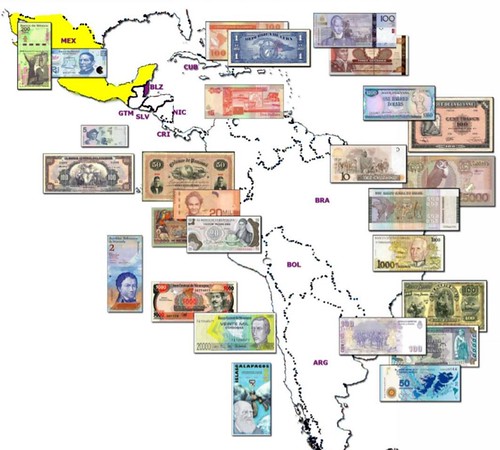
numismondo.net/articles/Maps_on_LA_PM/
Maps%20on%20LA%20Paper%20Money.pdf

